The
Ancient World...
The
ancient world was far
flung and full of mysteries, legends, adventures, romances,
and battles
won and lost... and eons later we are still excavating the
reminders
of those times... All the antiquities listed below are
guaranteed to
be authentic, and dated as best as we possibly can... and please
remember
to hit "reload" each time you visit the page...
(and you can see some more ancient beads on the "Southeast Asia" page as well.)
Reference books
cited here are:
"the History of
Beads: from 30,000 B.C.
to the Present" by Lois Sherr Dubin
"Beads of the World"
by Peter Francis
"Collectible
Beads: a Universal Aesthetic"
by Robert K. Liu
"Magical Ancient
Beads" by Jamey D. Allen
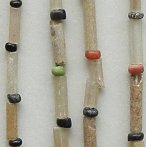 AN557. This is a group of delicate glass tubular beads in a
creamy colour accented by seed beads of various colours. Strand
#1 has 17 inches of beads plus pendant. $100.US/each (#5 is sold, the rest are available)
AN557. This is a group of delicate glass tubular beads in a
creamy colour accented by seed beads of various colours. Strand
#1 has 17 inches of beads plus pendant. $100.US/each (#5 is sold, the rest are available)
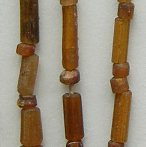 AN558. Here is a group of "gold" glass ancient
beads. I was very lucky to find a trove of ancient beads to be
able to offer them at a reasonable price. These are all real,
none are copies. There are 18 inches of beads on strand #1.
These can show off a small pendant beautifully. $150.US/each (#3 is available - the others are sold)
AN558. Here is a group of "gold" glass ancient
beads. I was very lucky to find a trove of ancient beads to be
able to offer them at a reasonable price. These are all real,
none are copies. There are 18 inches of beads on strand #1.
These can show off a small pendant beautifully. $150.US/each (#3 is available - the others are sold)
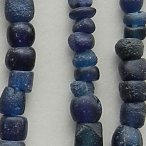 AN560. I haven't had fat ancient beads like these for
years. What a treat! Strand #1 is black and the other
strands are blue, darker than in the photo. These caught the
light when I was photographing them so came out brighter than they
really are. There are interesting shapes and textures among the
strands. Strand #1 has 17 inches of beads plus pendant. It
even has one raised eye bead (3 eyes) close to the pendant.
$135.US/each (#3 is available, the rest are sold)
AN560. I haven't had fat ancient beads like these for
years. What a treat! Strand #1 is black and the other
strands are blue, darker than in the photo. These caught the
light when I was photographing them so came out brighter than they
really are. There are interesting shapes and textures among the
strands. Strand #1 has 17 inches of beads plus pendant. It
even has one raised eye bead (3 eyes) close to the pendant.
$135.US/each (#3 is available, the rest are sold)
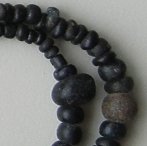 AN561. These black beads are all ancient glass.
Strand #1 is 17 inches around. $120.US/each strand (#1 is available, #2 is sold)
AN561. These black beads are all ancient glass.
Strand #1 is 17 inches around. $120.US/each strand (#1 is available, #2 is sold)
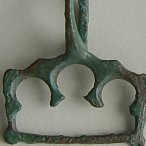 AN564. Here are two ancient bronze fittings, perhaps for a
belt used with horses? I buy only the ones that can work as
pendants and these both have very big loops on them. Pendant #1
is 1 5/8 inches tall - $55.US, and #2 is 1 3/4 inches tall -
$55.US. (#1 is sold, #2 is available)
AN564. Here are two ancient bronze fittings, perhaps for a
belt used with horses? I buy only the ones that can work as
pendants and these both have very big loops on them. Pendant #1
is 1 5/8 inches tall - $55.US, and #2 is 1 3/4 inches tall -
$55.US. (#1 is sold, #2 is available)
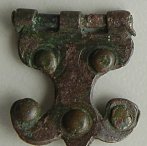 AN565. The first ancient bronze fitting on the left looks
like the remains of a hinge. There are two spaces under the top
tube to use for stringing. 1 1/2 inches tall -
$60.US. Pendant #2 has a hole at one end which can be used
for stringing. There are spaces within the design that would work
too with some imagination. #2 is just under 1 3/4 inches tall -
$65.US.
AN565. The first ancient bronze fitting on the left looks
like the remains of a hinge. There are two spaces under the top
tube to use for stringing. 1 1/2 inches tall -
$60.US. Pendant #2 has a hole at one end which can be used
for stringing. There are spaces within the design that would work
too with some imagination. #2 is just under 1 3/4 inches tall -
$65.US.
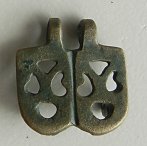 AN566. There are two smaller ancient bronze fittings here
which can be used as pendants. Pendant #1 is slightly over 1 1/2
inches tall. One of the spaces that you see in the pattern canbe
used for stringing - $45.US. Pendant #2 is 1 1/8 inches
tall. At the top it has loops (they don't close) and at the other
end are two holed pieces that stick out - perfect for hanging - $40.US.
AN566. There are two smaller ancient bronze fittings here
which can be used as pendants. Pendant #1 is slightly over 1 1/2
inches tall. One of the spaces that you see in the pattern canbe
used for stringing - $45.US. Pendant #2 is 1 1/8 inches
tall. At the top it has loops (they don't close) and at the other
end are two holed pieces that stick out - perfect for hanging - $40.US.
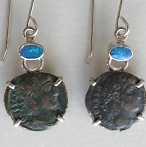 AN574. This pair of earrings made with bronze ancient Roman
coins have a beautiful deep aqua green/blue gemstone. The coins
are set with sterling silver, and the earrings measure just under 1 1/2
inches tall. I bought this group a number of years ago and am
selling them at the old price. $55.US
AN574. This pair of earrings made with bronze ancient Roman
coins have a beautiful deep aqua green/blue gemstone. The coins
are set with sterling silver, and the earrings measure just under 1 1/2
inches tall. I bought this group a number of years ago and am
selling them at the old price. $55.US
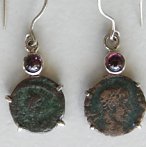 AN575. This
pair of
earrings made with bronze ancient Roman coins have a beautiful deep
garnet coloured gemstone. The coins are set with sterling silver,
and
the earrings measure 1 1/2 inches tall. $55.US
AN575. This
pair of
earrings made with bronze ancient Roman coins have a beautiful deep
garnet coloured gemstone. The coins are set with sterling silver,
and
the earrings measure 1 1/2 inches tall. $55.US
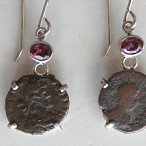 AN576. This
pair of
earrings made with bronze ancient Roman coins have a beautiful deep
pink facet gemstone. The coins are set with sterling silver, and
the earrings measure just under 1 1/2 inches tall. $55.US
AN576. This
pair of
earrings made with bronze ancient Roman coins have a beautiful deep
pink facet gemstone. The coins are set with sterling silver, and
the earrings measure just under 1 1/2 inches tall. $55.US
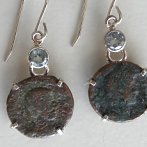 AN577. This
pair of
earrings made with bronze ancient Roman coins have a beautiful blue
facet gemstone. The coins are set with sterling silver, and
the earrings measure just under 1 1/2 inches tall. $55.US
AN577. This
pair of
earrings made with bronze ancient Roman coins have a beautiful blue
facet gemstone. The coins are set with sterling silver, and
the earrings measure just under 1 1/2 inches tall. $55.US
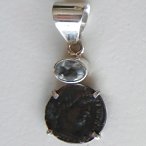 AN578. There are two pendants set with ancient Roman coins
shown here, with #1 being just under 1 3/8 inches tall and set with an
oval pale blue gemstone - $65.US. Pendant #2 is 1 3/8
inches tall and set with a round very deeply coloured facet garnet
gemstone - $65.US.
AN578. There are two pendants set with ancient Roman coins
shown here, with #1 being just under 1 3/8 inches tall and set with an
oval pale blue gemstone - $65.US. Pendant #2 is 1 3/8
inches tall and set with a round very deeply coloured facet garnet
gemstone - $65.US.
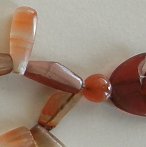 AN582. Necklace of ancient carnelian beads out of
Afghanistan - 16 inches of beads plus 1 1/5 inch long pendant.
(pendant is made of 3 beads) - $385.US.
AN582. Necklace of ancient carnelian beads out of
Afghanistan - 16 inches of beads plus 1 1/5 inch long pendant.
(pendant is made of 3 beads) - $385.US.
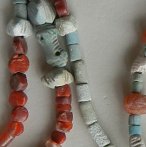 AN584. I have two strands of ancient beads here, both
including carnelian and faience. There is a close-up on the full
size photo. Strand #1 is 29 inches long - $165.US.
Strand #2 is 22 inches around with a central carnelian stone 1/2 inch
across - $155.US. (#1 is sold, #2 is available)
AN584. I have two strands of ancient beads here, both
including carnelian and faience. There is a close-up on the full
size photo. Strand #1 is 29 inches long - $165.US.
Strand #2 is 22 inches around with a central carnelian stone 1/2 inch
across - $155.US. (#1 is sold, #2 is available)
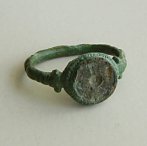 AN585.
This ancient Roman ring must have had some sort of stone or stamp in
the center of this ring. It is bare but looks great with the dot
in the middle. The ring band is a bit flattened rather than round
- it was probably under some pressure when buried. It is a size
6.5. $45.US.
AN585.
This ancient Roman ring must have had some sort of stone or stamp in
the center of this ring. It is bare but looks great with the dot
in the middle. The ring band is a bit flattened rather than round
- it was probably under some pressure when buried. It is a size
6.5. $45.US.
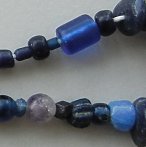 AN591. This is kind of a wild strand of beads here.
Most are ancient but there are a few more modern ones thrown in as
well. The strand has 17 inches of beads on it plus an antique
pendant. $95.US.
AN591. This is kind of a wild strand of beads here.
Most are ancient but there are a few more modern ones thrown in as
well. The strand has 17 inches of beads on it plus an antique
pendant. $95.US.
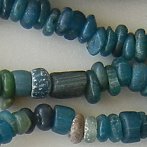 AN593. Here are some gorgeous deep sea coloured ancient
(Roman period) blue glass beads. These came from the trade route
crossing Mali and were made either in Roman glass factories of Europe
or North Africa. Strand #1 has 25 inches of beads on it - you can
use that measurement to compare to the rest. These are a
beautiful rich deep colour. $210.US/each strand
AN593. Here are some gorgeous deep sea coloured ancient
(Roman period) blue glass beads. These came from the trade route
crossing Mali and were made either in Roman glass factories of Europe
or North Africa. Strand #1 has 25 inches of beads on it - you can
use that measurement to compare to the rest. These are a
beautiful rich deep colour. $210.US/each strand
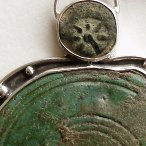 AN594. This is a magnificent necklace - only one like this
was made by the jewellery artist. The central dark green bronze
piece is from Roman times - perhaps something that went onto a door way
or... and is set in sterling silver. It looks beautiful
with the four coins, one in each direction. The pendant is
3 1/2 inches tall (including hanging loop) and 3 inches wide. It
hands on a sturdy silver chain made in Thailand which is 16 inches
around and closes with an "S" hook.
AN594. This is a magnificent necklace - only one like this
was made by the jewellery artist. The central dark green bronze
piece is from Roman times - perhaps something that went onto a door way
or... and is set in sterling silver. It looks beautiful
with the four coins, one in each direction. The pendant is
3 1/2 inches tall (including hanging loop) and 3 inches wide. It
hands on a sturdy silver chain made in Thailand which is 16 inches
around and closes with an "S" hook.
The top coin is a Widow's mite (103-76BC) "And Jesus sat over against
the treasury, and beheld how the people cast money into the
treasury: and many that were rich cast in much. And there
came a poor widow, and she threw in two mites... and he called
unto him his disciples, and saith unto them - Verily I say unto you,
that this poor widow hath cast more in, than all they which have cast
into the treasury: for all they did cast in of their
abundance; but she of her want did cast in all she had"
Mark 12: 41-44"
The coin on the right is Theodosius I (the Great) - Flavius Theodosius
(379-395AD) "Reuniting the eastern and western portions of the
empire, Theodosius was the last emperor of both the Eastern and Western
Roman Empire. After his death, the two parts split
permanently. He is also known for making Christianity the
official state religion of the Roman Empire."
The coin on the bottom is Valentinian I - Flavius Valentinianus
(364-375AD) "Was Roman Emperor from 364 until his death.
Valentinian is often referred to as the 'last great western
emperor'. Valeninian's chief work was guarding the frontiers and
establishing military positions. Valentinian was a Christian but
permitted liberal religious freedom to all his subjects, proscribing
only some forms of rituals such as particular tyles of sacrifices, and
banning the practice of magic".
The coin on the left is Arcadius - Flavius Arcadius (395-408AD)
"Was Roman Emperor in the Eastern half of the Roman Empire until his
death in 395AD. Arcadius was not interested in the affairs of the
state and the government was rules by others. His brother
Honorius ruled the Western half of the Roman Empire". $994.US.
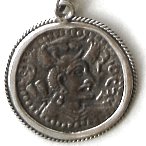 AN595. This is a beautiful rare Sassanid (Sassanian)
dirhem. One the obverse (the front) is the Great King and on the
reverse is an Altar. The coin was made around 200AD. The
coins is framed in sterling silver and measures just under 1 1/4 inches
in diameter. The sterling silver chain was made in Thailand and
measures 32 inches around. I find Sassanian ancient material to
very magical in its beauty. $468.US.
AN595. This is a beautiful rare Sassanid (Sassanian)
dirhem. One the obverse (the front) is the Great King and on the
reverse is an Altar. The coin was made around 200AD. The
coins is framed in sterling silver and measures just under 1 1/4 inches
in diameter. The sterling silver chain was made in Thailand and
measures 32 inches around. I find Sassanian ancient material to
very magical in its beauty. $468.US.
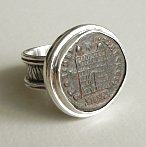 AN596. This sterling silver ring is set with an ancient
Roman bronze coin. It is a coin of Constans - Flavius Julius
Constans (337-350AD) "In 337 he succeeded his father (Constantine
the Great), jointly with his older brothers Constantine II and
Constantius II, receiving Italy, Pannonia and Africa as his
portion. Constans was tolerant of Judaism but promulgated an
edict banning pagan sacrifices in 341. In 341-2, Constans led a
successful campaign against Franks. The coin is known as the
"Camp Gate" and was struck in Heraclea about 315AD". Size
8. $120.US.
AN596. This sterling silver ring is set with an ancient
Roman bronze coin. It is a coin of Constans - Flavius Julius
Constans (337-350AD) "In 337 he succeeded his father (Constantine
the Great), jointly with his older brothers Constantine II and
Constantius II, receiving Italy, Pannonia and Africa as his
portion. Constans was tolerant of Judaism but promulgated an
edict banning pagan sacrifices in 341. In 341-2, Constans led a
successful campaign against Franks. The coin is known as the
"Camp Gate" and was struck in Heraclea about 315AD". Size
8. $120.US.
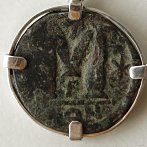 AN597. Here is a coin from the Byzantine empire, set in
sterling silver. "Some date the beginnings of the Byzantine
Empire at 476AD after the Roman Emperor Romulus Augustulus. After
the Ottoman Turks conquered Constantinople in 1453AD the Roman Empire
completely fell. The terms Byzantine Empire (a historiographical
term used since the 19th century) and Eastern Roman Empire are
expressions used to describe the Roman Empire of the Middle Ages.
The "M" on the reverse of these bronze coins represents the
denomination 40 nummi. (M = 40. K = 20. I - 10.
E = 5)" the pendant (including hanging loop) is 1 7/8 inches
tall. $65.US.
AN597. Here is a coin from the Byzantine empire, set in
sterling silver. "Some date the beginnings of the Byzantine
Empire at 476AD after the Roman Emperor Romulus Augustulus. After
the Ottoman Turks conquered Constantinople in 1453AD the Roman Empire
completely fell. The terms Byzantine Empire (a historiographical
term used since the 19th century) and Eastern Roman Empire are
expressions used to describe the Roman Empire of the Middle Ages.
The "M" on the reverse of these bronze coins represents the
denomination 40 nummi. (M = 40. K = 20. I - 10.
E = 5)" the pendant (including hanging loop) is 1 7/8 inches
tall. $65.US.
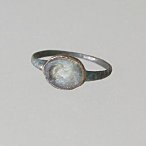 AN336. This ancient Roman ring is about a size 4 but not
really
for wearing. It has a tiny carved seal within it - a profile
portrait against clear glass. It is amazingly small about
5/16
inch long. This is an amazing piece for a collection.
I
haven't done anything to try to clean the ring itself but it seems to
be bronze. $225.US.
AN336. This ancient Roman ring is about a size 4 but not
really
for wearing. It has a tiny carved seal within it - a profile
portrait against clear glass. It is amazingly small about
5/16
inch long. This is an amazing piece for a collection.
I
haven't done anything to try to clean the ring itself but it seems to
be bronze. $225.US.
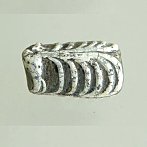 AN341. This Islamic bead from the Iran area is
recently
excavated. It is not fully cleaned as you can see on the
photo.
The local museum glass curator suggests that dirt be
carefully
brushed off but that ancient beads should not be washed. The
bead
has clear white raised trails on it and the dark base of the bead has
some glistening colour from age peeking through. The bead is
slightly longer than 7/8 inches long and 1/2 inch in diameter.
It
is a good clear example. $145.US.
AN341. This Islamic bead from the Iran area is
recently
excavated. It is not fully cleaned as you can see on the
photo.
The local museum glass curator suggests that dirt be
carefully
brushed off but that ancient beads should not be washed. The
bead
has clear white raised trails on it and the dark base of the bead has
some glistening colour from age peeking through. The bead is
slightly longer than 7/8 inches long and 1/2 inch in diameter.
It
is a good clear example. $145.US.
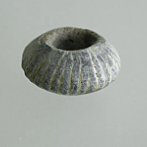 AN342.
This fat holed faience bead is 7/8 inch across and 3/8 inch
tall. It is from the Persia/Iran area. $35.US.
AN342.
This fat holed faience bead is 7/8 inch across and 3/8 inch
tall. It is from the Persia/Iran area. $35.US.
FOR
THE COINS BELOW - IF YOU SEE THE PREVIEW SQUARE AT 1 1/4 INCHES TALL,
THEN YOU WILL SEE THE COINS AT LIFE SIZE. THE SECONDARY IMAGE
IS
AN ENLARGEMENT SO THAT YOU CAN SEE THE DETAILS
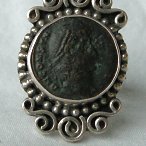 AN361. This is a beautifully made silver ring with an
ancient coin as its centerpiece. The coin is of Constantius
II,
Flavius Iulius Constantius minted in the 4th century A.D. He
was
the second of the three sons of Constantine the Great.
Constantius eventually met and crushed Magnentius in the
Battle
of Mursa Major, one of the bloodiest battles in Roman History.
The ring is 1 1/8 inch across from top to bottom in the
image,
and the coin is just under 5/8 inch across. The ring is a
size 8.
$75.US.
AN361. This is a beautifully made silver ring with an
ancient coin as its centerpiece. The coin is of Constantius
II,
Flavius Iulius Constantius minted in the 4th century A.D. He
was
the second of the three sons of Constantine the Great.
Constantius eventually met and crushed Magnentius in the
Battle
of Mursa Major, one of the bloodiest battles in Roman History.
The ring is 1 1/8 inch across from top to bottom in the
image,
and the coin is just under 5/8 inch across. The ring is a
size 8.
$75.US.
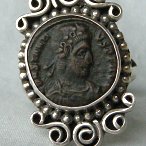 AN362. This
is a beautifully made silver
ring with an ancient coin as its centerpiece. The coin is of
Constantius II, Flavius Iulius Constantius minted in the 4th century
A.D. He was the second of the three sons of Constantine the
Great.
Constantius eventually met and crushed Magnentius in the
Battle
of
Mursa Major, one of the bloodiest battles in Roman History.
The
ring
is a little more than 1 1/8 inch across from the top to the bottom of
the image, and the coin is just under 5/8 inch across. The
ring
is a size 7.5. $75.US.
AN362. This
is a beautifully made silver
ring with an ancient coin as its centerpiece. The coin is of
Constantius II, Flavius Iulius Constantius minted in the 4th century
A.D. He was the second of the three sons of Constantine the
Great.
Constantius eventually met and crushed Magnentius in the
Battle
of
Mursa Major, one of the bloodiest battles in Roman History.
The
ring
is a little more than 1 1/8 inch across from the top to the bottom of
the image, and the coin is just under 5/8 inch across. The
ring
is a size 7.5. $75.US.
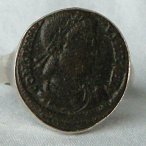 AN372. This
is a beautifully made silver
ring with an ancient coin as its centerpiece. The coin is of
Constantius II, Flavius Iulius Constantius minted in the 4th century
A.D.
He
was the second of the three sons of Constantine the Great.
Constantius eventually met and crushed Magnentius in the
Battle of
Mursa Major, one of the bloodiest battles in Roman History.
The coin is just over 11/16 inch across. The ring
is a
size 8. $70.US.
AN372. This
is a beautifully made silver
ring with an ancient coin as its centerpiece. The coin is of
Constantius II, Flavius Iulius Constantius minted in the 4th century
A.D.
He
was the second of the three sons of Constantine the Great.
Constantius eventually met and crushed Magnentius in the
Battle of
Mursa Major, one of the bloodiest battles in Roman History.
The coin is just over 11/16 inch across. The ring
is a
size 8. $70.US.
THERE ARE MORE ANCIENT COIN PIECES FURTHER BELOW AS WELL....
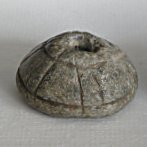 AN384. Here are three stone spindle whorls carved in
ancient times found in Anatolia. The largest one is 1 1/8 inches
across. They can easily be used as beads. The three beads
were part of a collection and are sold together for $225.US.
AN384. Here are three stone spindle whorls carved in
ancient times found in Anatolia. The largest one is 1 1/8 inches
across. They can easily be used as beads. The three beads
were part of a collection and are sold together for $225.US.
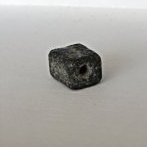 AN388. This is a small rectangular seal bead, and I do mean
"small". It is 7/16 inches long, 3/8 inch wide and 5/16 inches
tall. It is lightly crusted with a patination, and age has made
the patterns look quite vague. I believe that the larger images
are figures of people judging by the moulded image, but I don't
know. $65.US.
AN388. This is a small rectangular seal bead, and I do mean
"small". It is 7/16 inches long, 3/8 inch wide and 5/16 inches
tall. It is lightly crusted with a patination, and age has made
the patterns look quite vague. I believe that the larger images
are figures of people judging by the moulded image, but I don't
know. $65.US.
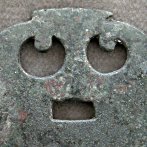 AN393.
This bronze piece is probably an Islamic design (over 800 years
old) that was probably originally some kind of belt ornament. I
has a very gentle curve to it, and graceful cut-outs. There are
no hanging loops but the top cut-outs can be used to put a cord
through. The piece is just under 1 7/8 inches across and 1 5/8
inches tall. It has a great dark green patina to it - I do like
to protect patinas by careful wear. $150.US.
AN393.
This bronze piece is probably an Islamic design (over 800 years
old) that was probably originally some kind of belt ornament. I
has a very gentle curve to it, and graceful cut-outs. There are
no hanging loops but the top cut-outs can be used to put a cord
through. The piece is just under 1 7/8 inches across and 1 5/8
inches tall. It has a great dark green patina to it - I do like
to protect patinas by careful wear. $150.US.
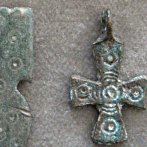 AN394. There are four pieces here. #1 is a stamped
bronze piece 1 3/8 inches tall with an interesting floral design on it.
It has no way to fasten it, but a piece could be glued against
the back, perhaps a panel that allows a string to pass behind it.
$30.US. #2 is the end of a Byzantine belt - the photo is
of the rougher side, the other side is quite perfect. The ending
that the leather belt would be inserted into is open so that a thick
ribbon or leather piece could be used again. The piece is 1 5/8
inches tall and has a beautiful dark green patina to it.
$135.US. #3 is a very typical Byzantine cross. It seems
that a zillion of these were made out of bronze in the 8th to 10th
centuries--all with the same circles in the center and on the arms of
each cross... They are so similar that they could have almost
been made from the same one mold - and were popular with a large
proportion of people living then. $150.US. #4 is some
kind of fitting that I can't quite decide on. It has a beautiful
pale green patina, is a little over 1 3/8 inches tall, has 4 stringing
holes, and is flat on the back. $65.US. (#1, #3 & #4 are sold - #2 is available)
AN394. There are four pieces here. #1 is a stamped
bronze piece 1 3/8 inches tall with an interesting floral design on it.
It has no way to fasten it, but a piece could be glued against
the back, perhaps a panel that allows a string to pass behind it.
$30.US. #2 is the end of a Byzantine belt - the photo is
of the rougher side, the other side is quite perfect. The ending
that the leather belt would be inserted into is open so that a thick
ribbon or leather piece could be used again. The piece is 1 5/8
inches tall and has a beautiful dark green patina to it.
$135.US. #3 is a very typical Byzantine cross. It seems
that a zillion of these were made out of bronze in the 8th to 10th
centuries--all with the same circles in the center and on the arms of
each cross... They are so similar that they could have almost
been made from the same one mold - and were popular with a large
proportion of people living then. $150.US. #4 is some
kind of fitting that I can't quite decide on. It has a beautiful
pale green patina, is a little over 1 3/8 inches tall, has 4 stringing
holes, and is flat on the back. $65.US. (#1, #3 & #4 are sold - #2 is available)
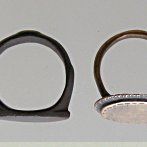 AN403. I have a series of ancient rings (almost all are
bronze) which I collected 20 years ago or so. They are wearable
with one thing to keep in mind. If they are worn often the patina
(a coloured coating building up on the ring over many years) will wear
down and the metal itself will show again. It is best to maintain
the patina as part of the history of the piece.
AN403. I have a series of ancient rings (almost all are
bronze) which I collected 20 years ago or so. They are wearable
with one thing to keep in mind. If they are worn often the patina
(a coloured coating building up on the ring over many years) will wear
down and the metal itself will show again. It is best to maintain
the patina as part of the history of the piece.
Ring
#1 has a nice dark green patina on it. It has a very graceful
Islamic shape to it with an "eye" shaped decoration at the front.
I like its grace and simplicity. size 8.5
$185.US. Ring #2 has a wide, flat top on it that has no
decorations other than a simple dashed line around the edge of the
oval. behind that is a ridge which has small lines cut into it,
almost like a shallow ruffle. On the side of the oval which lies
against the finger are lines radiating outwards from the center of the
oval. It is quite perfect. size 8.5 $165.US.
Ring #3 is also made of bronze with a dark green patina. It is a
Byzantine piece with an attractive design on the front that makes me
think of a star image. It could have been used to sign documents
on wax. size 8.5 $165.US.
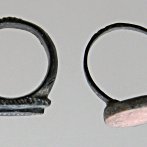 AN404. There are three more rings here, each of a
distinctive style. Ring #1 has a thick and well decorated
band. There are small bits of etching, relief and design all
around the band culminating in a sprue decorated with a few diagonal
lines. The bezel of the ring is flower shaped and has a cross
type design impressed into it with an engraver's tool.
AN404. There are three more rings here, each of a
distinctive style. Ring #1 has a thick and well decorated
band. There are small bits of etching, relief and design all
around the band culminating in a sprue decorated with a few diagonal
lines. The bezel of the ring is flower shaped and has a cross
type design impressed into it with an engraver's tool.
This
was a silver woman's ring, probably Islamic, from the 11th Century or
so. size 6 $165.US. Ring #2 is an eye ring - worn
in Islamic countries to ward away evil. This ring has an eye
shaped bezel which has an etched design within the eye, which looks
sort of like Arabic script, but isn't really. It is probably a
design that was originally derived from the decorative aspect of
script... There are also some lines of etching to each side of
the center eye, and the low sprue in the back is decorated with a
series of vertical lines. size 8.5 $165.US. #3 is
very unusual Roman ring. The cabochon is glass I believe (though
it could be a pale peach/pink stone) with the image of a cow or steer
on it. Above that is written: COS VII (a latin
inscription). Someone very knowledgeable in ancient coinage
explained to me "The inscription COS VII means that the owner (could be
an emperor) was consul 7 times. "COS" is short for consul. The
consulship during the Republic was the highest office in the Roman
world. (The appt. was only for 1 year to maintain checks and balances).
size 11 $250.US. (#1 is sold)
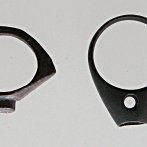 AN405. There are two ancient rings here. #1 is a
flanged ring typical of early Roman ones. The catalog of the
British Museum collection of ancient rings illustrates a few similar
types--often cast in gold, but also in silver and bronze. This
ring fits beautifully on one of the smallest finger of a woman's hand,
and is surprisingly very comfortable. It has a simple design
carved into the circular bezel, which may be a very abstraced portrait.
I would place this ring around the 3rd Century A.D. size 5.
$195.US. #2 is quite interesting in its construction.
It has a raised opening where a stone must have sat over a
thousand years ago. One could fasten in a correctly sized round
cabochon. I don't know what the hole across the ring is for, but
think it looks great. size 7 $110.US.
AN405. There are two ancient rings here. #1 is a
flanged ring typical of early Roman ones. The catalog of the
British Museum collection of ancient rings illustrates a few similar
types--often cast in gold, but also in silver and bronze. This
ring fits beautifully on one of the smallest finger of a woman's hand,
and is surprisingly very comfortable. It has a simple design
carved into the circular bezel, which may be a very abstraced portrait.
I would place this ring around the 3rd Century A.D. size 5.
$195.US. #2 is quite interesting in its construction.
It has a raised opening where a stone must have sat over a
thousand years ago. One could fasten in a correctly sized round
cabochon. I don't know what the hole across the ring is for, but
think it looks great. size 7 $110.US.
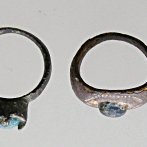 AN406. Ring #1 is bronze with the original blue glass
stone sitting in it. size 5.5 $95.US. #2 is a
bronze ring with a brown patina on it. It has a centerpiece of a
blue glass stone with an image carved into it. It is too worn
though to see what was pictured there. The ring is oval so
difficult to measure exactly. approximately size 5.5
$125.US. #3 is a silver oval ring - very traditional in Roman
times - with a clear image of a standing figure carved into the red
oval cabochon. It is very tiny with an opening at the back and a
size 3 or so. $110.US. (#1 & #3 are available, #2 is sold)
AN406. Ring #1 is bronze with the original blue glass
stone sitting in it. size 5.5 $95.US. #2 is a
bronze ring with a brown patina on it. It has a centerpiece of a
blue glass stone with an image carved into it. It is too worn
though to see what was pictured there. The ring is oval so
difficult to measure exactly. approximately size 5.5
$125.US. #3 is a silver oval ring - very traditional in Roman
times - with a clear image of a standing figure carved into the red
oval cabochon. It is very tiny with an opening at the back and a
size 3 or so. $110.US. (#1 & #3 are available, #2 is sold)
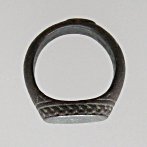 AN408. This is a heavy bronze ring made for one of the
smaller fingers of a man's hand... It has a dark green patination
but one can see the brass underneath at corners. There is some
delicate etching around the bezel, and a simple pattern on the top, of
two swirls meeting... probably symbolizing harmony, balance, and
perhaps infinity. The back of the ring where the original sprue was
(the channel where the molten metal was poured into the original mold
of the ring) still has a low remnant of the sprue which has been shaped
and carved with a flower design. This ring is a very collectible
piece. size 9.5 $350.US.
AN408. This is a heavy bronze ring made for one of the
smaller fingers of a man's hand... It has a dark green patination
but one can see the brass underneath at corners. There is some
delicate etching around the bezel, and a simple pattern on the top, of
two swirls meeting... probably symbolizing harmony, balance, and
perhaps infinity. The back of the ring where the original sprue was
(the channel where the molten metal was poured into the original mold
of the ring) still has a low remnant of the sprue which has been shaped
and carved with a flower design. This ring is a very collectible
piece. size 9.5 $350.US.
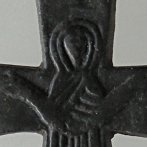 AN410. This Byzantine cross from Bulgaria has only one
hinge attached to the top portion of the cross so can't be hung upright
as is unless you can attach something to the broken hinge - it does
have two secure loops at the opposite end. This would normally
have been only the front half of the cross. The hinge at the
bottom would have attached the front to a nearly identical (but
undecorated) back piece. The loops at the top would have
interlocked so that when a cord was passed through, the two sides would
remain closed. Inside this reliquary cross a pilgrim or a
religious devotee would have placed items of devotional and spiritual
importance. These crosses are found broken more often than not,
and continued to be highly valued and still worn in that state...
2 1/2" high $350.US.
AN410. This Byzantine cross from Bulgaria has only one
hinge attached to the top portion of the cross so can't be hung upright
as is unless you can attach something to the broken hinge - it does
have two secure loops at the opposite end. This would normally
have been only the front half of the cross. The hinge at the
bottom would have attached the front to a nearly identical (but
undecorated) back piece. The loops at the top would have
interlocked so that when a cord was passed through, the two sides would
remain closed. Inside this reliquary cross a pilgrim or a
religious devotee would have placed items of devotional and spiritual
importance. These crosses are found broken more often than not,
and continued to be highly valued and still worn in that state...
2 1/2" high $350.US.
THE
ROMAN BRONZE COINS FEATURED IN THE JEWELRY PIECES BELOW ARE MUCH MORE
ATTRACTIVE IN REALITY THAN IN THE PHOTOS. I DO HAVE SOME
DIFFICULTY IN GETTING GOOD CLOSE-UPS OF SUCH DARK OBJECTS. THEY
ARE MORE DISTINCT AND PLEASING AND LOOK PERFECT IN THEIR SETTINGS...
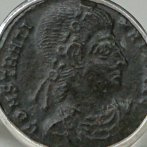 AN415. This silver ring (image enlarged) has a bronze coin of
Constantius II (Flavius Julius Constantius - Caesar, 323-337;
Augustus, 337 - 361 AD). Constantius was the second of the three sons
of Constantine the Great. Constantius eventually met and crushed
Magnentius in the Gattle of Mursa Major, one of the bloodiest battles
in Roman History. Constantius took an active part in the affairs of
the Christian church, he is not remembered as a restorer of unity, but
as a heretic who arbitrarily imposed his will on the church. Size 9.5. $68.US.
AN415. This silver ring (image enlarged) has a bronze coin of
Constantius II (Flavius Julius Constantius - Caesar, 323-337;
Augustus, 337 - 361 AD). Constantius was the second of the three sons
of Constantine the Great. Constantius eventually met and crushed
Magnentius in the Gattle of Mursa Major, one of the bloodiest battles
in Roman History. Constantius took an active part in the affairs of
the Christian church, he is not remembered as a restorer of unity, but
as a heretic who arbitrarily imposed his will on the church. Size 9.5. $68.US.
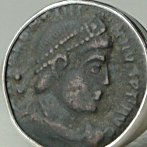 AN420. This silver ring (image enlarged) has a bronze coin of
Constantius II (Flavius Julius Constantius - Caesar, 323-337;
Augustus, 337 - 361 AD). Constantius was the second of the three sons
of Constantine the Great. Constantius eventually met and crushed
Magnentius in the Gattle of Mursa Major, one of the bloodiest battles
in Roman History. Constantius took an active part in the affairs of
the Christian church, he is not remembered as a restorer of unity, but
as a heretic who arbitrarily imposed his will on the church. Size 9. $68.US.
AN420. This silver ring (image enlarged) has a bronze coin of
Constantius II (Flavius Julius Constantius - Caesar, 323-337;
Augustus, 337 - 361 AD). Constantius was the second of the three sons
of Constantine the Great. Constantius eventually met and crushed
Magnentius in the Gattle of Mursa Major, one of the bloodiest battles
in Roman History. Constantius took an active part in the affairs of
the Christian church, he is not remembered as a restorer of unity, but
as a heretic who arbitrarily imposed his will on the church. Size 9. $68.US.
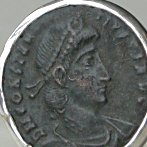 AN421. This silver ring (image enlarged) has a bronze coin of
Constantius II (Flavius Julius Constantius - Caesar, 323-337;
Augustus, 337 - 361 AD). Constantius was the second of the three sons
of Constantine the Great. Constantius eventually met and crushed
Magnentius in the Gattle of Mursa Major, one of the bloodiest battles
in Roman History. Constantius took an active part in the affairs of
the Christian church, he is not remembered as a restorer of unity, but
as a heretic who arbitrarily imposed his will on the church. Size 9. $78.US.
AN421. This silver ring (image enlarged) has a bronze coin of
Constantius II (Flavius Julius Constantius - Caesar, 323-337;
Augustus, 337 - 361 AD). Constantius was the second of the three sons
of Constantine the Great. Constantius eventually met and crushed
Magnentius in the Gattle of Mursa Major, one of the bloodiest battles
in Roman History. Constantius took an active part in the affairs of
the Christian church, he is not remembered as a restorer of unity, but
as a heretic who arbitrarily imposed his will on the church. Size 9. $78.US.
 AN422. This sterling silver ring (image enlarged) has a bronze coin of
Constantius Gallus (Flavius Claudius Constantius Gallus 325/326 -
354AD) the son of Julius Constantius by his first wife Galla.
Gallus' paternal grandparents were Western Roman Emperor
Constantius Chlorus and his second wife Flavia Maximiana Theodora.
Julius Constantius was also a half-brother of Roman Emperor
Constantine I, and thus Gallus was a first cousin of Emperors
Constantine II, Constantius II, and Constans. Size 7.
$86.US.
AN422. This sterling silver ring (image enlarged) has a bronze coin of
Constantius Gallus (Flavius Claudius Constantius Gallus 325/326 -
354AD) the son of Julius Constantius by his first wife Galla.
Gallus' paternal grandparents were Western Roman Emperor
Constantius Chlorus and his second wife Flavia Maximiana Theodora.
Julius Constantius was also a half-brother of Roman Emperor
Constantine I, and thus Gallus was a first cousin of Emperors
Constantine II, Constantius II, and Constans. Size 7.
$86.US.
IF
YOU SEE THE PREVIEW SQUARES BELOW, 1 1/2 INCHES WIDE, THEN YOU WILL SEE
THE PIECES ACTUAL SIZE. When you click on the previews, most of
the images have enlarged photos so that you can see more of the
details.....
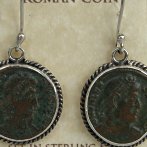 AN423. These silver earrings feature two different bronze
coins. One coin is of Valens and the other is of Constantius II.
From the top of the earwire to the bottoms of the coins the
earrings measure 1 9/16 inches tall. $138.US.
AN423. These silver earrings feature two different bronze
coins. One coin is of Valens and the other is of Constantius II.
From the top of the earwire to the bottoms of the coins the
earrings measure 1 9/16 inches tall. $138.US.
Valens (Flavius
Julius Valens 364-378 AD) is credited with the commission of a short
history of the Roman State. This work, produced by Valens'
secretary Eutropius, and known with the name Breviarium ab Urbe
condita, tells the story of Rome from its founding. According to
some historians, Valens was motivated by the necessity of learning
Roman history so that he, the royal family and their appointees might
better mix with the Roman Senatorial class. Valens was sometimes
known as the Last True Roman Emperor. His succesor was Theodosius
I.
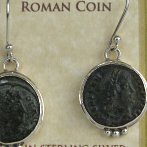 AN424. These silver earrings feature two different bronze
coins. One coin is of Valens and the other is of Constantius II.
From the top of the earwire to the bottoms of the coins the
earrings measure 1 1/2 inches tall. $108.US.
AN424. These silver earrings feature two different bronze
coins. One coin is of Valens and the other is of Constantius II.
From the top of the earwire to the bottoms of the coins the
earrings measure 1 1/2 inches tall. $108.US.
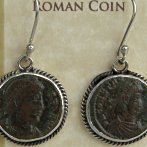 AN425. These silver earrings feature two different bronze
coins. One coin is of Constantius II and the other is of Valens.
From the top of the earwire to the bottoms of the coins the
earrings measure 1 1/2 inches tall. $128.US.
AN425. These silver earrings feature two different bronze
coins. One coin is of Constantius II and the other is of Valens.
From the top of the earwire to the bottoms of the coins the
earrings measure 1 1/2 inches tall. $128.US.
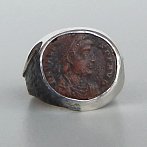 AN446.
This ring features a coin of Valens - Flavius Julius Valens
(364-378AD). Valens is credited with the commission of a short
history of the Roman State called Breviarium ab Urbe condita. It
tells the story of Rome from its founding. He was motivated by
the necessity of learning Roman history, that he, the royal family and
their appointees might better mix with the Roman Senatorial
class. Valens was sometimes known as the Last True Roman
Emperor. His successor was Theodosius I. Size
11.5. $145.US.
AN446.
This ring features a coin of Valens - Flavius Julius Valens
(364-378AD). Valens is credited with the commission of a short
history of the Roman State called Breviarium ab Urbe condita. It
tells the story of Rome from its founding. He was motivated by
the necessity of learning Roman history, that he, the royal family and
their appointees might better mix with the Roman Senatorial
class. Valens was sometimes known as the Last True Roman
Emperor. His successor was Theodosius I. Size
11.5. $145.US.
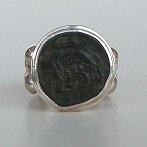 AN447. This size 10 ring has an interesting bronze coin
sit into it. This is a coin commemorating Romulus and Remus the
traditional founders of Rome. They appear in Roman mythology as
the twin sons of the priestess Rhea Silvia with the god of war - Mars.
Romulus slew Remus ove a dispute about which one of the two
brothers had the support of the local deities to rule the new city and
give it his name. The name they gave the city was Rome. The
twins suckling from the wolf are generally on coins from the
Constantine era, circa 306-324AD as a commemorative issue representing
the founders of Rome. $160.US.
AN447. This size 10 ring has an interesting bronze coin
sit into it. This is a coin commemorating Romulus and Remus the
traditional founders of Rome. They appear in Roman mythology as
the twin sons of the priestess Rhea Silvia with the god of war - Mars.
Romulus slew Remus ove a dispute about which one of the two
brothers had the support of the local deities to rule the new city and
give it his name. The name they gave the city was Rome. The
twins suckling from the wolf are generally on coins from the
Constantine era, circa 306-324AD as a commemorative issue representing
the founders of Rome. $160.US.
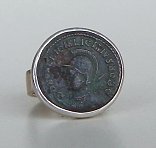 AN449. This ring is a size 7 and set with a bronze coin
of Licinius. (Flavius Galerius Valerius Licinianus Licinius)
(308-324AD) Of Dacian peasant origin, born in Moesia Superior,
Licinius accompanied his close friend the Emperor Galerius on the
Persian expedition in 297. Galerius elevated Licinius to the rank
of Augustus in the west on November 11, 308. He received as his
immediate command the provinces of Illyricum, Thrace and Pannonia (the
western half of the Roman Empire). $84.US.
AN449. This ring is a size 7 and set with a bronze coin
of Licinius. (Flavius Galerius Valerius Licinianus Licinius)
(308-324AD) Of Dacian peasant origin, born in Moesia Superior,
Licinius accompanied his close friend the Emperor Galerius on the
Persian expedition in 297. Galerius elevated Licinius to the rank
of Augustus in the west on November 11, 308. He received as his
immediate command the provinces of Illyricum, Thrace and Pannonia (the
western half of the Roman Empire). $84.US.
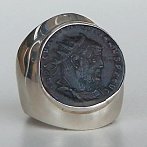 AN450. Maximianus (Gaius Valerius Galerius Maximinus)
(308-313AD) He was originally a peasant named Daia, the nephew of
Galerius, his predecessor. He rose to high distinction after he had
joined the army, and in 305 he was adopted by his maternal uncle
Galerius. He was raised to the rank of Caesar with the governments of
Syria and Aegyptus. In 308 after the elevation of Licinius to
Augustus, Maximinus and Constantine were declared filii Augustorum
(sons of the Augusti). $128.US.
AN450. Maximianus (Gaius Valerius Galerius Maximinus)
(308-313AD) He was originally a peasant named Daia, the nephew of
Galerius, his predecessor. He rose to high distinction after he had
joined the army, and in 305 he was adopted by his maternal uncle
Galerius. He was raised to the rank of Caesar with the governments of
Syria and Aegyptus. In 308 after the elevation of Licinius to
Augustus, Maximinus and Constantine were declared filii Augustorum
(sons of the Augusti). $128.US.
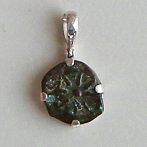 AN454. Widows Mite set in silver. See description above. $88.US.
AN454. Widows Mite set in silver. See description above. $88.US.
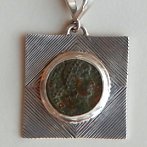 AN457. This pendant is of Constantinius II.
(Flavius Julius Constantius) (Caesar 323-337; Augustus 337-361AD)
Constantius was the second of the three sons of Constantine the Great.
Constantius eventually met and crushed Magnentius in the Battle of
Mursa Major, one of the bloodiest battles in Roman history.
Constantius took an active part in the affairs of the Christian
church. He is not remembered as a restorer of unity though, but as a
heretic who arbitrarily imposed his will on the church. $88.US.
AN457. This pendant is of Constantinius II.
(Flavius Julius Constantius) (Caesar 323-337; Augustus 337-361AD)
Constantius was the second of the three sons of Constantine the Great.
Constantius eventually met and crushed Magnentius in the Battle of
Mursa Major, one of the bloodiest battles in Roman history.
Constantius took an active part in the affairs of the Christian
church. He is not remembered as a restorer of unity though, but as a
heretic who arbitrarily imposed his will on the church. $88.US.
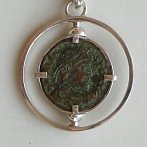 AN464. This is a pendant of Valentinian I. (Flavius
Valentinianus) (364-375AD) He was the Roman Emperor from 364
until his death. Valentinian is often referred to as the "last
great western emperor". Valentinian's chief work was guarding the
frontiers and establishing military positions. Valentinian was a
Christian but permitted liberal religious freedom to all his subjects,
proscribing only some forms of rituals such as particular types of
sacrifices and banning the practice of magic... $68.US.
AN464. This is a pendant of Valentinian I. (Flavius
Valentinianus) (364-375AD) He was the Roman Emperor from 364
until his death. Valentinian is often referred to as the "last
great western emperor". Valentinian's chief work was guarding the
frontiers and establishing military positions. Valentinian was a
Christian but permitted liberal religious freedom to all his subjects,
proscribing only some forms of rituals such as particular types of
sacrifices and banning the practice of magic... $68.US.
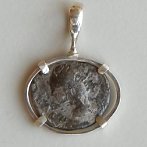 AN469. This is a pendant with a coin of Faustina the
Elder. (Annia Galeria Faustina) Wife of Roman Emperor
Antoninus Pius, Emperor from 138-161AD. Throughout her life
Faustina as a private citizen and an empress was involved in assisting
with charities, the poor and sponsoring in the education of Roman
children, particularly of Roman girls. She founded a charity
called Puellae Faustinianae or Girls of Faustina which assisted
orphaned girls. She can be viewed as one of the most moral,
stable and respected empresses in the history of the Roman Empire.
$76.US.
AN469. This is a pendant with a coin of Faustina the
Elder. (Annia Galeria Faustina) Wife of Roman Emperor
Antoninus Pius, Emperor from 138-161AD. Throughout her life
Faustina as a private citizen and an empress was involved in assisting
with charities, the poor and sponsoring in the education of Roman
children, particularly of Roman girls. She founded a charity
called Puellae Faustinianae or Girls of Faustina which assisted
orphaned girls. She can be viewed as one of the most moral,
stable and respected empresses in the history of the Roman Empire.
$76.US.
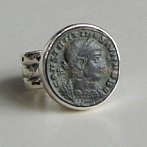 AN502. This ring features a coin of Constantine II.
(Flavius Claudius Julius Constantinius) (337-340AD)
Son of Constantine the Great. Joint emperor with his
brothers Constantius and Constans. Constantine II was involved in
military expeditions from an early age. In AD323 he took part in
Constantine I's campaigns against the Samaritans. Soon after the
death of his half-brother Crispus in 326, at the age of 10, he was
nominally put in command of Gaul. Constantine II's generals
apparently won a victory over the Alamanni. Size 7.
$128.US.
AN502. This ring features a coin of Constantine II.
(Flavius Claudius Julius Constantinius) (337-340AD)
Son of Constantine the Great. Joint emperor with his
brothers Constantius and Constans. Constantine II was involved in
military expeditions from an early age. In AD323 he took part in
Constantine I's campaigns against the Samaritans. Soon after the
death of his half-brother Crispus in 326, at the age of 10, he was
nominally put in command of Gaul. Constantine II's generals
apparently won a victory over the Alamanni. Size 7.
$128.US.
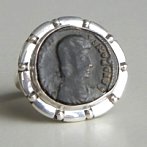 AN505. This ring has a bronze coin of
Constantius Gallus (Flavius Claudius Constantius Gallus 325/326 -
354AD) the son of Julius Constantius by his first wife Galla.
Gallus' paternal grandparents were Western Roman Emperor
Constantius Chlorus and his second wife Flavia Maximiana Theodora.
Julius Constantius was also a half-brother of Roman Emperor
Constantine I, and thus Gallus was a first cousin of Emperors
Constantine II, Constantius II, and Constans. Gallus was very good looking with soft blonde hair. Size 10.
$128.US.
AN505. This ring has a bronze coin of
Constantius Gallus (Flavius Claudius Constantius Gallus 325/326 -
354AD) the son of Julius Constantius by his first wife Galla.
Gallus' paternal grandparents were Western Roman Emperor
Constantius Chlorus and his second wife Flavia Maximiana Theodora.
Julius Constantius was also a half-brother of Roman Emperor
Constantine I, and thus Gallus was a first cousin of Emperors
Constantine II, Constantius II, and Constans. Gallus was very good looking with soft blonde hair. Size 10.
$128.US.
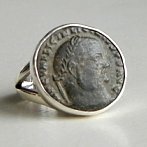 AN506. This ring is set with a coin of Licinius. (Flavius Galerius
Valerius Licinianus Licinius) (308-324AD) Of Dacian peasant origin,
born in Moesia Superior, Licinius accompanied his close friend the
Emperor Galerius on the Persian expedition in 297. Galerius elevated
Licinius to the rank of Augustus in the west on November 11, 308. He
received as his immediate command the provinces of Illyricum, Thrace
and Pannonia (the western half of the Roman Empire). Size 11. $148.US.
AN506. This ring is set with a coin of Licinius. (Flavius Galerius
Valerius Licinianus Licinius) (308-324AD) Of Dacian peasant origin,
born in Moesia Superior, Licinius accompanied his close friend the
Emperor Galerius on the Persian expedition in 297. Galerius elevated
Licinius to the rank of Augustus in the west on November 11, 308. He
received as his immediate command the provinces of Illyricum, Thrace
and Pannonia (the western half of the Roman Empire). Size 11. $148.US.
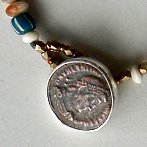 AN507. The coin/button on this bracelet is of Valentinian I. (Flavius
Valentinianus) (364-375AD) He was the Roman Emperor from 364
until his death. Valentinian is often referred to as the "last
great western emperor". Valentinian's chief work was guarding the
frontiers and establishing military positions. Valentinian was a
Christian but permitted liberal religious freedom to all his subjects,
proscribing only some forms of rituals such as particular types of
sacrifices and banning the practice of magic... 7 1/3 inches around. $108.US.
AN507. The coin/button on this bracelet is of Valentinian I. (Flavius
Valentinianus) (364-375AD) He was the Roman Emperor from 364
until his death. Valentinian is often referred to as the "last
great western emperor". Valentinian's chief work was guarding the
frontiers and establishing military positions. Valentinian was a
Christian but permitted liberal religious freedom to all his subjects,
proscribing only some forms of rituals such as particular types of
sacrifices and banning the practice of magic... 7 1/3 inches around. $108.US.
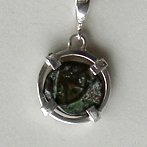 AN508. This coin pendant is set with a
Widows Mite. (103-76BC Bibilical coins) "And Jesus sat
over against the treasury, and beheld how the people cast money into
the treasury: and many that were rich cast in much. And
there came a certain poor widow, and she threw in two Mites...
And he called unto him his disciples and saith unto them - Verily
I say unto you that this poor widow hath cast more in, than all they
which have cast into the treasury: for all they did cast in of
their abundance: but she of her want did cast in all she had."
Mark 12:41-44 $88.US.
AN508. This coin pendant is set with a
Widows Mite. (103-76BC Bibilical coins) "And Jesus sat
over against the treasury, and beheld how the people cast money into
the treasury: and many that were rich cast in much. And
there came a certain poor widow, and she threw in two Mites...
And he called unto him his disciples and saith unto them - Verily
I say unto you that this poor widow hath cast more in, than all they
which have cast into the treasury: for all they did cast in of
their abundance: but she of her want did cast in all she had."
Mark 12:41-44 $88.US.
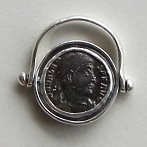 AN513. This
style of ring sold out quickly last time. You flip the coin and
it can be worn with either side facing upwards - when it is set aside
it sits flat like in the photo. This size 6 ring has a bronze
coin of Valens.
(Flavius Julius Valens) (364-378AD) Valens is credited with
the commission of a short history of the Roman State. This work,
produced by Valens' secretary Eutropius, and known with the name
Breviarium ab Urbe condita, tells the story of Rome from its founding.
According to some historians, Valens was motivated by the
necessity of learning Roman history so that he, the royal family and
their appointees might better mix with the Roman Senatorial class.
Valens was sometimes known as the Last True Roman Emperor.
His successor was Theodosius I. $128.US.
AN513. This
style of ring sold out quickly last time. You flip the coin and
it can be worn with either side facing upwards - when it is set aside
it sits flat like in the photo. This size 6 ring has a bronze
coin of Valens.
(Flavius Julius Valens) (364-378AD) Valens is credited with
the commission of a short history of the Roman State. This work,
produced by Valens' secretary Eutropius, and known with the name
Breviarium ab Urbe condita, tells the story of Rome from its founding.
According to some historians, Valens was motivated by the
necessity of learning Roman history so that he, the royal family and
their appointees might better mix with the Roman Senatorial class.
Valens was sometimes known as the Last True Roman Emperor.
His successor was Theodosius I. $128.US.
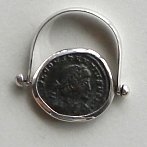 AN514. This style of
ring sold out quickly last time. You flip the coin and it can be worn
with either side facing upwards - when it is set aside it sits flat
like in the photo. This
ring features a coin of Constantine II. (Flavius Claudius Julius
Constantinius) (337-340AD) Son of Constantine the Great. Joint
emperor with his brothers Constantius and Constans. Constantine II was
involved in military expeditions from an early age. In AD323 he took
part in Constantine I's campaigns against the Samaritans. Soon after
the death of his half-brother Crispus in 326, at the age of 10, he was
nominally put in command of Gaul. Constantine II's generals apparently
won a victory over the Alamanni. Size 9. $88.US.
AN514. This style of
ring sold out quickly last time. You flip the coin and it can be worn
with either side facing upwards - when it is set aside it sits flat
like in the photo. This
ring features a coin of Constantine II. (Flavius Claudius Julius
Constantinius) (337-340AD) Son of Constantine the Great. Joint
emperor with his brothers Constantius and Constans. Constantine II was
involved in military expeditions from an early age. In AD323 he took
part in Constantine I's campaigns against the Samaritans. Soon after
the death of his half-brother Crispus in 326, at the age of 10, he was
nominally put in command of Gaul. Constantine II's generals apparently
won a victory over the Alamanni. Size 9. $88.US.
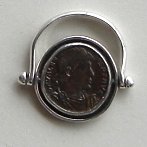 AN515. This style of
ring sold out quickly last time. You flip the coin and it can be worn
with either side facing upwards - when it is set aside it sits flat
like in the photo. The size 6.5 ring is set with a coin of Valentinian I. (Flavius
Valentinianus) (364-375AD) He was the Roman Emperor from 364
until his death. Valentinian is often referred to as the "last
great western emperor". Valentinian's chief work was guarding the
frontiers and establishing military positions. Valentinian was a
Christian but permitted liberal religious freedom to all his subjects,
proscribing only some forms of rituals such as particular types of
sacrifices and banning the practice of magic... $138.US.
AN515. This style of
ring sold out quickly last time. You flip the coin and it can be worn
with either side facing upwards - when it is set aside it sits flat
like in the photo. The size 6.5 ring is set with a coin of Valentinian I. (Flavius
Valentinianus) (364-375AD) He was the Roman Emperor from 364
until his death. Valentinian is often referred to as the "last
great western emperor". Valentinian's chief work was guarding the
frontiers and establishing military positions. Valentinian was a
Christian but permitted liberal religious freedom to all his subjects,
proscribing only some forms of rituals such as particular types of
sacrifices and banning the practice of magic... $138.US.
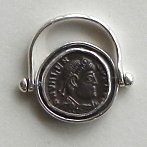 AN516. This style of
ring sold out quickly last time. You flip the coin and it can be worn
with either side facing upwards - when it is set aside it sits flat
like in the photo. This size 6 ring has a bronze coin of Valens.
(Flavius Julius Valens) (364-378AD) Valens is credited with
the commission of a short history of the Roman State. This work,
produced by Valens' secretary Eutropius, and known with the name
Breviarium ab Urbe condita, tells the story of Rome from its founding.
According to some historians, Valens was motivated by the
necessity of learning Roman history so that he, the royal family and
their appointees might better mix with the Roman Senatorial class.
Valens was sometimes known as the Last True Roman Emperor.
His successor was Theodosius I. $138.US.
AN516. This style of
ring sold out quickly last time. You flip the coin and it can be worn
with either side facing upwards - when it is set aside it sits flat
like in the photo. This size 6 ring has a bronze coin of Valens.
(Flavius Julius Valens) (364-378AD) Valens is credited with
the commission of a short history of the Roman State. This work,
produced by Valens' secretary Eutropius, and known with the name
Breviarium ab Urbe condita, tells the story of Rome from its founding.
According to some historians, Valens was motivated by the
necessity of learning Roman history so that he, the royal family and
their appointees might better mix with the Roman Senatorial class.
Valens was sometimes known as the Last True Roman Emperor.
His successor was Theodosius I. $138.US.
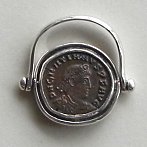 AN517. This style of
ring sold out quickly last time. You flip the coin and it can be worn
with either side facing upwards - when it is set aside it sits flat
like in the photo. This
size 6.5 ring is
set with a coin of Gratian. (Flavius Gratianus Augustus)
(375-383) He was the eldest son of Valentinian I.
During his youth Gratian accompanied his father on serveral
campaigns. Upon the death of Valentinian in 375 Gratian's brother
Valentinian II was declared emperor by his father's soldiers.
$118.US.
AN517. This style of
ring sold out quickly last time. You flip the coin and it can be worn
with either side facing upwards - when it is set aside it sits flat
like in the photo. This
size 6.5 ring is
set with a coin of Gratian. (Flavius Gratianus Augustus)
(375-383) He was the eldest son of Valentinian I.
During his youth Gratian accompanied his father on serveral
campaigns. Upon the death of Valentinian in 375 Gratian's brother
Valentinian II was declared emperor by his father's soldiers.
$118.US.
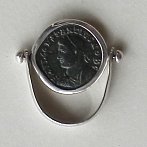 AN518. This style of
ring sold out quickly last time. You flip the coin and it can be worn
with either side facing upwards - when it is set aside it sits flat
like in the photo. This size 6 ring has a coin of Constantinius II.
(Flavius Julius Constantius) (Caesar 323-337; Augustus 337-361AD)
Constantius was the second of the three sons of Constantine the Great.
Constantius eventually met and crushed Magnentius in the Battle of
Mursa Major, one of the bloodiest battles in Roman history.
Constantius took an active part in the affairs of the Christian
church. He is not remembered as a restorer of unity though, but as a
heretic who arbitrarily imposed his will on the church. $98.US.
AN518. This style of
ring sold out quickly last time. You flip the coin and it can be worn
with either side facing upwards - when it is set aside it sits flat
like in the photo. This size 6 ring has a coin of Constantinius II.
(Flavius Julius Constantius) (Caesar 323-337; Augustus 337-361AD)
Constantius was the second of the three sons of Constantine the Great.
Constantius eventually met and crushed Magnentius in the Battle of
Mursa Major, one of the bloodiest battles in Roman history.
Constantius took an active part in the affairs of the Christian
church. He is not remembered as a restorer of unity though, but as a
heretic who arbitrarily imposed his will on the church. $98.US.
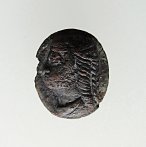 AN534. broken top from ancient ring - portrait - $245.US.
AN534. broken top from ancient ring - portrait - $245.US.
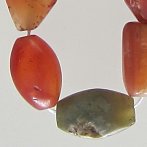 AN536. 4 3/5 inches carnelian beads - $120.US.
AN536. 4 3/5 inches carnelian beads - $120.US.
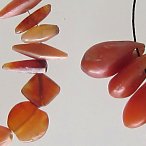 AN537. group #1 - 3 1/2 inches long. $130.US. (#1 is available - the rest are now sold)
AN537. group #1 - 3 1/2 inches long. $130.US. (#1 is available - the rest are now sold)
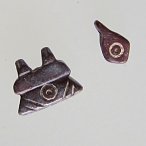 AN540. 3 ancient pendants - the larger one on the left is
5/8 inch wide at the bottom. $145.US.
AN540. 3 ancient pendants - the larger one on the left is
5/8 inch wide at the bottom. $145.US.
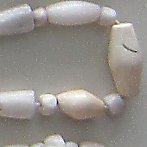 AN542. I have five strands of ancient shell beads here,
with some containing stone beads as well. These came out of
Afghanistan. Strand #1 has a little over 16 inches of beads on
the strand. The entire strand is 22 inches long but the important
part is the beaded section. The beads are $110.US/each strand
AN542. I have five strands of ancient shell beads here,
with some containing stone beads as well. These came out of
Afghanistan. Strand #1 has a little over 16 inches of beads on
the strand. The entire strand is 22 inches long but the important
part is the beaded section. The beads are $110.US/each strand
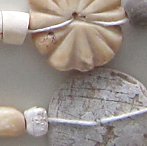 AN543. Here are more shell beads that came out of
Afghanistan. Many of the pieces/beads are carved, some
deliberately as necklace pieces and some are reused buttons or other
practical pieces. Strand #1 has 18 inches of beads on it.
The entire strand including the string part is 25 inches around.
The bottom rounded piece is 1 1/2 inches across. The variety of
colour, shape and carving is intriguing & charming on both
strands. $420.US/each strand (#1 is sold, #2 is available)
AN543. Here are more shell beads that came out of
Afghanistan. Many of the pieces/beads are carved, some
deliberately as necklace pieces and some are reused buttons or other
practical pieces. Strand #1 has 18 inches of beads on it.
The entire strand including the string part is 25 inches around.
The bottom rounded piece is 1 1/2 inches across. The variety of
colour, shape and carving is intriguing & charming on both
strands. $420.US/each strand (#1 is sold, #2 is available)
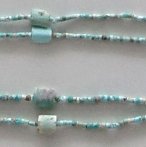 AN551. I haven't had any of these perfect tiny ancient
turquoise beads from the Middle East for quite a few years so I was
happy to encounter them again. You need to have patience to
re-string these but of course whoever strung these already did a
beautiful job with a fine double strand of thread. Strand #1
has13 3/4 inches of beads on it. The central pendant is made of
two beads adding up to 5/8 inch tall. $125.US/each
strand (#8 is available - the rest are sold)
AN551. I haven't had any of these perfect tiny ancient
turquoise beads from the Middle East for quite a few years so I was
happy to encounter them again. You need to have patience to
re-string these but of course whoever strung these already did a
beautiful job with a fine double strand of thread. Strand #1
has13 3/4 inches of beads on it. The central pendant is made of
two beads adding up to 5/8 inch tall. $125.US/each
strand (#8 is available - the rest are sold)
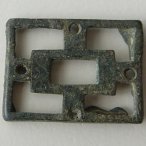 AN552.
This is part of a Roman Buckle or perhaps a piece from a horse's
harness. It is made of bronze and nicely patinated in a dark
green. It has holes on the sides and on the top in the
photo. The bottom hole isn't pierced all the way through.
The piece is 1 inch by 1 3/8 inches. This could be used as an
interesting pendant. $35.US.
AN552.
This is part of a Roman Buckle or perhaps a piece from a horse's
harness. It is made of bronze and nicely patinated in a dark
green. It has holes on the sides and on the top in the
photo. The bottom hole isn't pierced all the way through.
The piece is 1 inch by 1 3/8 inches. This could be used as an
interesting pendant. $35.US.
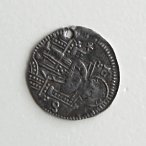 AN553. I have two silver Byzantine coins here, both holed in
antiquity. I do not hole ancient coins and hope that others don't
either, but keep them in their current form. They are always
beautiful with their fine lines and details portraying both Christ and
the current emperor. Coin #1 is 7/8 inches across.
$110.US. Coin #2 is 3/4 inch across. $95.US.
AN553. I have two silver Byzantine coins here, both holed in
antiquity. I do not hole ancient coins and hope that others don't
either, but keep them in their current form. They are always
beautiful with their fine lines and details portraying both Christ and
the current emperor. Coin #1 is 7/8 inches across.
$110.US. Coin #2 is 3/4 inch across. $95.US.
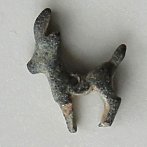 AN495. Here is a sweet small bronze animal from Bactria
C. 4th Century BC. It has a pair of horns at the front and pair
of ears behind so must be some type of deer. It is holed across
the chest to use as a pendant. The creature had an accident
hundreds of years ago which removed his front left leg but lost none of his
charm. The deer is 1 1/4 inches tall and slightly over one inch
from tip of nose to tail. $180.US.
AN495. Here is a sweet small bronze animal from Bactria
C. 4th Century BC. It has a pair of horns at the front and pair
of ears behind so must be some type of deer. It is holed across
the chest to use as a pendant. The creature had an accident
hundreds of years ago which removed his front left leg but lost none of his
charm. The deer is 1 1/4 inches tall and slightly over one inch
from tip of nose to tail. $180.US.
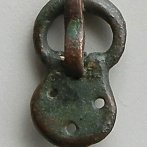 AN496. These are all ancient bronze pieces from various
digs in Europe which can be used to make rather interesting pendants.
#1 is a cone shaped piece with a single stringing hole - it is 2
inches tall. #2 is a buckle 1 5/8 inches tall, and #3 is a little
over 1 5/8 inches tall, flat, with a number of piercings to turn it
into a pendant. $28.US/each piece (#2 is available, the others are sold)
AN496. These are all ancient bronze pieces from various
digs in Europe which can be used to make rather interesting pendants.
#1 is a cone shaped piece with a single stringing hole - it is 2
inches tall. #2 is a buckle 1 5/8 inches tall, and #3 is a little
over 1 5/8 inches tall, flat, with a number of piercings to turn it
into a pendant. $28.US/each piece (#2 is available, the others are sold)
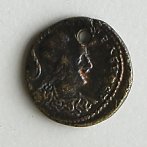 AN484. This is a very attractive ancient holed coin.
(holed in antiquity). It is bronze and 1 inch in diameter.
I was originally told that it is a coin of the Crusades but truly
know nothing. If a coin researcher sees this, I would love to
know exactly where the coin is from and what it represents.
$75.US.
AN484. This is a very attractive ancient holed coin.
(holed in antiquity). It is bronze and 1 inch in diameter.
I was originally told that it is a coin of the Crusades but truly
know nothing. If a coin researcher sees this, I would love to
know exactly where the coin is from and what it represents.
$75.US.
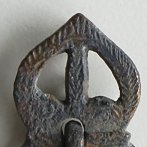 AN485. This ancient bronze buckle came out of Bulgaria.
It has a brownish patina on it, and will hang nicely as a pendant
as it has a 3/8 inch long post behind the point at the top, with a hole
going through it where the stringing cord could go. It is
attractively decorates with delicate little lines, still visible under
the patina. The piece is 2 inches tall. $95.US.
AN485. This ancient bronze buckle came out of Bulgaria.
It has a brownish patina on it, and will hang nicely as a pendant
as it has a 3/8 inch long post behind the point at the top, with a hole
going through it where the stringing cord could go. It is
attractively decorates with delicate little lines, still visible under
the patina. The piece is 2 inches tall. $95.US.
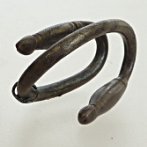 AN437. Here is an interesting pair of hair rings from the
Roman Empire. After the amount of years that have passed it is
not obviously clear what the metal is - it might easily be silver whose
surface has changed after long burial. There are some nice
details of design on these pieces to give an attractive look when wound
around curls or braids - elastic bands didn't exist close to 2000 years
ago... One of the loops has a little metal ring around it so
perhaps something decorative was once attached. The rings measure
about 1 1/4 inches across. $230.US/pair.
AN437. Here is an interesting pair of hair rings from the
Roman Empire. After the amount of years that have passed it is
not obviously clear what the metal is - it might easily be silver whose
surface has changed after long burial. There are some nice
details of design on these pieces to give an attractive look when wound
around curls or braids - elastic bands didn't exist close to 2000 years
ago... One of the loops has a little metal ring around it so
perhaps something decorative was once attached. The rings measure
about 1 1/4 inches across. $230.US/pair.
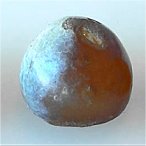 AN/EA709. Item
#1 is an ancient agate bead with hole going through and remains of
ancient
patterns. $155.US. There are also three ancient
gaming pieces
- tall domes with flat bottoms made of agate - very charming and
sculptural...
#2 - 7/8 inches tall and 1 1/8 inch across -
$135.US. #3 - 7/8
inch tall and 1 inch across with dot in the middle of the flat bottom -
$125.US. #4 - 7/8 inch tall and 7/8 inch across -
$115.US. They are fascinating to look into and to hold
against a light. They look very good in a
display case.
AN/EA709. Item
#1 is an ancient agate bead with hole going through and remains of
ancient
patterns. $155.US. There are also three ancient
gaming pieces
- tall domes with flat bottoms made of agate - very charming and
sculptural...
#2 - 7/8 inches tall and 1 1/8 inch across -
$135.US. #3 - 7/8
inch tall and 1 inch across with dot in the middle of the flat bottom -
$125.US. #4 - 7/8 inch tall and 7/8 inch across -
$115.US. They are fascinating to look into and to hold
against a light. They look very good in a
display case.
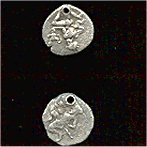 AN190. These are
tiny silver coins, all less than 1/2 inch across. You can see
the images
better in real life than on the scans. All of the coins that
I sell
were holed in their own times, generally to be used in ancient
jewellery...
Most of this selection is Greek and the artistry of the designers shows
well
in the coins. #1 is from Macedon, Eion. It is a
silver Trihemiobol
c. 480BC. On one side it has a goose with its head turned
back and
a lizard laid above it. On the back is an incuse
square. $40.US.
#2 is Hellenistic from the Carian Islands of Rhodes. It is a
hemidrachm dating from 408-394BC. One one side it has the
radiate head of Helios and on the other side, a rose. The
head of Helios lies on its side because
of where the stringing hole is, and is very easy to see in real life -
though
confusing on the scan. $75.US. (sold)
#3 is from Macedonia, Neapolis. It is a hemidrachm dating
from 411-348BC. On one side is a Gorgon head facing forward,
and on the reverse is the laureate
head of Artemis. $75.US. Coins
#4 through #8 are
from Thasos, and many used to be used strung together to make necklaces
in
ancient times. They were about partying and about
drinking. The
coins date from about 411-350BC and each show a Satyr kneeling and
holding
Kantharos which is a two handles drinking cup. The reverse
shows an
Amphora which would be filled with wine. The prices
are: #4 -
$65.US, #5 - $65.US (sold),
#6 - $50.US,
#7 - $40.US, #8 - $30.US (sold).
(#6 is the only coin available here)
AN190. These are
tiny silver coins, all less than 1/2 inch across. You can see
the images
better in real life than on the scans. All of the coins that
I sell
were holed in their own times, generally to be used in ancient
jewellery...
Most of this selection is Greek and the artistry of the designers shows
well
in the coins. #1 is from Macedon, Eion. It is a
silver Trihemiobol
c. 480BC. On one side it has a goose with its head turned
back and
a lizard laid above it. On the back is an incuse
square. $40.US.
#2 is Hellenistic from the Carian Islands of Rhodes. It is a
hemidrachm dating from 408-394BC. One one side it has the
radiate head of Helios and on the other side, a rose. The
head of Helios lies on its side because
of where the stringing hole is, and is very easy to see in real life -
though
confusing on the scan. $75.US. (sold)
#3 is from Macedonia, Neapolis. It is a hemidrachm dating
from 411-348BC. On one side is a Gorgon head facing forward,
and on the reverse is the laureate
head of Artemis. $75.US. Coins
#4 through #8 are
from Thasos, and many used to be used strung together to make necklaces
in
ancient times. They were about partying and about
drinking. The
coins date from about 411-350BC and each show a Satyr kneeling and
holding
Kantharos which is a two handles drinking cup. The reverse
shows an
Amphora which would be filled with wine. The prices
are: #4 -
$65.US, #5 - $65.US (sold),
#6 - $50.US,
#7 - $40.US, #8 - $30.US (sold).
(#6 is the only coin available here)
to
place an order please click
here.
return to
"Contents" page
.....Eastern beads and ornaments
.....Southeast
Asia
.....India
.....Africa
.....African
trade beads
.....North
Africa
.....the
Americas including preColumbian
.....Europe
.........Mexico
-
traditional rebozos and market shopping
.....Contemporary jewelry
.....Collections
........Mexico Silver jewelry
 AN557. This is a group of delicate glass tubular beads in a
creamy colour accented by seed beads of various colours. Strand
#1 has 17 inches of beads plus pendant. $100.US/each (#5 is sold, the rest are available)
AN557. This is a group of delicate glass tubular beads in a
creamy colour accented by seed beads of various colours. Strand
#1 has 17 inches of beads plus pendant. $100.US/each (#5 is sold, the rest are available) AN558. Here is a group of "gold" glass ancient
beads. I was very lucky to find a trove of ancient beads to be
able to offer them at a reasonable price. These are all real,
none are copies. There are 18 inches of beads on strand #1.
These can show off a small pendant beautifully. $150.US/each (#3 is available - the others are sold)
AN558. Here is a group of "gold" glass ancient
beads. I was very lucky to find a trove of ancient beads to be
able to offer them at a reasonable price. These are all real,
none are copies. There are 18 inches of beads on strand #1.
These can show off a small pendant beautifully. $150.US/each (#3 is available - the others are sold) AN560. I haven't had fat ancient beads like these for
years. What a treat! Strand #1 is black and the other
strands are blue, darker than in the photo. These caught the
light when I was photographing them so came out brighter than they
really are. There are interesting shapes and textures among the
strands. Strand #1 has 17 inches of beads plus pendant. It
even has one raised eye bead (3 eyes) close to the pendant.
$135.US/each (#3 is available, the rest are sold)
AN560. I haven't had fat ancient beads like these for
years. What a treat! Strand #1 is black and the other
strands are blue, darker than in the photo. These caught the
light when I was photographing them so came out brighter than they
really are. There are interesting shapes and textures among the
strands. Strand #1 has 17 inches of beads plus pendant. It
even has one raised eye bead (3 eyes) close to the pendant.
$135.US/each (#3 is available, the rest are sold) AN561. These black beads are all ancient glass.
Strand #1 is 17 inches around. $120.US/each strand (#1 is available, #2 is sold)
AN561. These black beads are all ancient glass.
Strand #1 is 17 inches around. $120.US/each strand (#1 is available, #2 is sold) AN564. Here are two ancient bronze fittings, perhaps for a
belt used with horses? I buy only the ones that can work as
pendants and these both have very big loops on them. Pendant #1
is 1 5/8 inches tall - $55.US, and #2 is 1 3/4 inches tall -
$55.US. (#1 is sold, #2 is available)
AN564. Here are two ancient bronze fittings, perhaps for a
belt used with horses? I buy only the ones that can work as
pendants and these both have very big loops on them. Pendant #1
is 1 5/8 inches tall - $55.US, and #2 is 1 3/4 inches tall -
$55.US. (#1 is sold, #2 is available)  AN565. The first ancient bronze fitting on the left looks
like the remains of a hinge. There are two spaces under the top
tube to use for stringing. 1 1/2 inches tall -
$60.US. Pendant #2 has a hole at one end which can be used
for stringing. There are spaces within the design that would work
too with some imagination. #2 is just under 1 3/4 inches tall -
$65.US.
AN565. The first ancient bronze fitting on the left looks
like the remains of a hinge. There are two spaces under the top
tube to use for stringing. 1 1/2 inches tall -
$60.US. Pendant #2 has a hole at one end which can be used
for stringing. There are spaces within the design that would work
too with some imagination. #2 is just under 1 3/4 inches tall -
$65.US. AN566. There are two smaller ancient bronze fittings here
which can be used as pendants. Pendant #1 is slightly over 1 1/2
inches tall. One of the spaces that you see in the pattern canbe
used for stringing - $45.US. Pendant #2 is 1 1/8 inches
tall. At the top it has loops (they don't close) and at the other
end are two holed pieces that stick out - perfect for hanging - $40.US.
AN566. There are two smaller ancient bronze fittings here
which can be used as pendants. Pendant #1 is slightly over 1 1/2
inches tall. One of the spaces that you see in the pattern canbe
used for stringing - $45.US. Pendant #2 is 1 1/8 inches
tall. At the top it has loops (they don't close) and at the other
end are two holed pieces that stick out - perfect for hanging - $40.US.  AN574. This pair of earrings made with bronze ancient Roman
coins have a beautiful deep aqua green/blue gemstone. The coins
are set with sterling silver, and the earrings measure just under 1 1/2
inches tall. I bought this group a number of years ago and am
selling them at the old price. $55.US
AN574. This pair of earrings made with bronze ancient Roman
coins have a beautiful deep aqua green/blue gemstone. The coins
are set with sterling silver, and the earrings measure just under 1 1/2
inches tall. I bought this group a number of years ago and am
selling them at the old price. $55.US AN575.
AN575.  AN576.
AN576.  AN577.
AN577.  AN578. There are two pendants set with ancient Roman coins
shown here, with #1 being just under 1 3/8 inches tall and set with an
oval pale blue gemstone - $65.US. Pendant #2 is 1 3/8
inches tall and set with a round very deeply coloured facet garnet
gemstone - $65.US.
AN578. There are two pendants set with ancient Roman coins
shown here, with #1 being just under 1 3/8 inches tall and set with an
oval pale blue gemstone - $65.US. Pendant #2 is 1 3/8
inches tall and set with a round very deeply coloured facet garnet
gemstone - $65.US. AN582. Necklace of ancient carnelian beads out of
Afghanistan - 16 inches of beads plus 1 1/5 inch long pendant.
(pendant is made of 3 beads) - $385.US.
AN582. Necklace of ancient carnelian beads out of
Afghanistan - 16 inches of beads plus 1 1/5 inch long pendant.
(pendant is made of 3 beads) - $385.US. AN584. I have two strands of ancient beads here, both
including carnelian and faience. There is a close-up on the full
size photo. Strand #1 is 29 inches long - $165.US.
Strand #2 is 22 inches around with a central carnelian stone 1/2 inch
across - $155.US.
AN584. I have two strands of ancient beads here, both
including carnelian and faience. There is a close-up on the full
size photo. Strand #1 is 29 inches long - $165.US.
Strand #2 is 22 inches around with a central carnelian stone 1/2 inch
across - $155.US. 
 AN591. This is kind of a wild strand of beads here.
Most are ancient but there are a few more modern ones thrown in as
well. The strand has 17 inches of beads on it plus an antique
pendant. $95.US.
AN591. This is kind of a wild strand of beads here.
Most are ancient but there are a few more modern ones thrown in as
well. The strand has 17 inches of beads on it plus an antique
pendant. $95.US.  AN593. Here are some gorgeous deep sea coloured ancient
(Roman period) blue glass beads. These came from the trade route
crossing Mali and were made either in Roman glass factories of Europe
or North Africa. Strand #1 has 25 inches of beads on it - you can
use that measurement to compare to the rest. These are a
beautiful rich deep colour. $210.US/each strand
AN593. Here are some gorgeous deep sea coloured ancient
(Roman period) blue glass beads. These came from the trade route
crossing Mali and were made either in Roman glass factories of Europe
or North Africa. Strand #1 has 25 inches of beads on it - you can
use that measurement to compare to the rest. These are a
beautiful rich deep colour. $210.US/each strand AN594. This is a magnificent necklace - only one like this
was made by the jewellery artist. The central dark green bronze
piece is from Roman times - perhaps something that went onto a door way
or... and is set in sterling silver. It looks beautiful
with the four coins, one in each direction. The pendant is
3 1/2 inches tall (including hanging loop) and 3 inches wide. It
hands on a sturdy silver chain made in Thailand which is 16 inches
around and closes with an "S" hook.
AN594. This is a magnificent necklace - only one like this
was made by the jewellery artist. The central dark green bronze
piece is from Roman times - perhaps something that went onto a door way
or... and is set in sterling silver. It looks beautiful
with the four coins, one in each direction. The pendant is
3 1/2 inches tall (including hanging loop) and 3 inches wide. It
hands on a sturdy silver chain made in Thailand which is 16 inches
around and closes with an "S" hook. AN595. This is a beautiful rare Sassanid (Sassanian)
dirhem. One the obverse (the front) is the Great King and on the
reverse is an Altar. The coin was made around 200AD. The
coins is framed in sterling silver and measures just under 1 1/4 inches
in diameter. The sterling silver chain was made in Thailand and
measures 32 inches around. I find Sassanian ancient material to
very magical in its beauty. $468.US.
AN595. This is a beautiful rare Sassanid (Sassanian)
dirhem. One the obverse (the front) is the Great King and on the
reverse is an Altar. The coin was made around 200AD. The
coins is framed in sterling silver and measures just under 1 1/4 inches
in diameter. The sterling silver chain was made in Thailand and
measures 32 inches around. I find Sassanian ancient material to
very magical in its beauty. $468.US. AN596. This sterling silver ring is set with an ancient
Roman bronze coin. It is a coin of Constans - Flavius Julius
Constans (337-350AD) "In 337 he succeeded his father (Constantine
the Great), jointly with his older brothers Constantine II and
Constantius II, receiving Italy, Pannonia and Africa as his
portion. Constans was tolerant of Judaism but promulgated an
edict banning pagan sacrifices in 341. In 341-2, Constans led a
successful campaign against Franks. The coin is known as the
"Camp Gate" and was struck in Heraclea about 315AD". Size
8. $120.US.
AN596. This sterling silver ring is set with an ancient
Roman bronze coin. It is a coin of Constans - Flavius Julius
Constans (337-350AD) "In 337 he succeeded his father (Constantine
the Great), jointly with his older brothers Constantine II and
Constantius II, receiving Italy, Pannonia and Africa as his
portion. Constans was tolerant of Judaism but promulgated an
edict banning pagan sacrifices in 341. In 341-2, Constans led a
successful campaign against Franks. The coin is known as the
"Camp Gate" and was struck in Heraclea about 315AD". Size
8. $120.US. AN597. Here is a coin from the Byzantine empire, set in
sterling silver. "Some date the beginnings of the Byzantine
Empire at 476AD after the Roman Emperor Romulus Augustulus. After
the Ottoman Turks conquered Constantinople in 1453AD the Roman Empire
completely fell. The terms Byzantine Empire (a historiographical
term used since the 19th century) and Eastern Roman Empire are
expressions used to describe the Roman Empire of the Middle Ages.
The "M" on the reverse of these bronze coins represents the
denomination 40 nummi. (M = 40. K = 20. I - 10.
E = 5)" the pendant (including hanging loop) is 1 7/8 inches
tall. $65.US.
AN597. Here is a coin from the Byzantine empire, set in
sterling silver. "Some date the beginnings of the Byzantine
Empire at 476AD after the Roman Emperor Romulus Augustulus. After
the Ottoman Turks conquered Constantinople in 1453AD the Roman Empire
completely fell. The terms Byzantine Empire (a historiographical
term used since the 19th century) and Eastern Roman Empire are
expressions used to describe the Roman Empire of the Middle Ages.
The "M" on the reverse of these bronze coins represents the
denomination 40 nummi. (M = 40. K = 20. I - 10.
E = 5)" the pendant (including hanging loop) is 1 7/8 inches
tall. $65.US. AN336. This ancient Roman ring is about a size 4 but not
really
for wearing. It has a tiny carved seal within it - a profile
portrait against clear glass. It is amazingly small about
5/16
inch long. This is an amazing piece for a collection.
I
haven't done anything to try to clean the ring itself but it seems to
be bronze. $225.US.
AN336. This ancient Roman ring is about a size 4 but not
really
for wearing. It has a tiny carved seal within it - a profile
portrait against clear glass. It is amazingly small about
5/16
inch long. This is an amazing piece for a collection.
I
haven't done anything to try to clean the ring itself but it seems to
be bronze. $225.US.  AN341. This Islamic bead from the Iran area is
recently
excavated. It is not fully cleaned as you can see on the
photo.
The local museum glass curator suggests that dirt be
carefully
brushed off but that ancient beads should not be washed. The
bead
has clear white raised trails on it and the dark base of the bead has
some glistening colour from age peeking through. The bead is
slightly longer than 7/8 inches long and 1/2 inch in diameter.
It
is a good clear example. $145.US.
AN341. This Islamic bead from the Iran area is
recently
excavated. It is not fully cleaned as you can see on the
photo.
The local museum glass curator suggests that dirt be
carefully
brushed off but that ancient beads should not be washed. The
bead
has clear white raised trails on it and the dark base of the bead has
some glistening colour from age peeking through. The bead is
slightly longer than 7/8 inches long and 1/2 inch in diameter.
It
is a good clear example. $145.US.
 AN361. This is a beautifully made silver ring with an
ancient coin as its centerpiece. The coin is of Constantius
II,
Flavius Iulius Constantius minted in the 4th century A.D. He
was
the second of the three sons of Constantine the Great.
Constantius eventually met and crushed Magnentius in the
Battle
of Mursa Major, one of the bloodiest battles in Roman History.
The ring is 1 1/8 inch across from top to bottom in the
image,
and the coin is just under 5/8 inch across. The ring is a
size 8.
$75.US.
AN361. This is a beautifully made silver ring with an
ancient coin as its centerpiece. The coin is of Constantius
II,
Flavius Iulius Constantius minted in the 4th century A.D. He
was
the second of the three sons of Constantine the Great.
Constantius eventually met and crushed Magnentius in the
Battle
of Mursa Major, one of the bloodiest battles in Roman History.
The ring is 1 1/8 inch across from top to bottom in the
image,
and the coin is just under 5/8 inch across. The ring is a
size 8.
$75.US. AN362. This
is a beautifully made silver
ring with an ancient coin as its centerpiece. The coin is of
Constantius II, Flavius Iulius Constantius minted in the 4th century
A.D. He was the second of the three sons of Constantine the
Great.
Constantius eventually met and crushed Magnentius in the
Battle
of
Mursa Major, one of the bloodiest battles in Roman History.
The
ring
is a little more than 1 1/8 inch across from the top to the bottom of
the image, and the coin is just under 5/8 inch across. The
ring
is a size 7.5. $75.US.
AN362. This
is a beautifully made silver
ring with an ancient coin as its centerpiece. The coin is of
Constantius II, Flavius Iulius Constantius minted in the 4th century
A.D. He was the second of the three sons of Constantine the
Great.
Constantius eventually met and crushed Magnentius in the
Battle
of
Mursa Major, one of the bloodiest battles in Roman History.
The
ring
is a little more than 1 1/8 inch across from the top to the bottom of
the image, and the coin is just under 5/8 inch across. The
ring
is a size 7.5. $75.US. AN372. This
is a beautifully made silver
ring with an ancient coin as its centerpiece. The coin is of
Constantius II, Flavius Iulius Constantius minted in the 4th century
A.D.
He
was the second of the three sons of Constantine the Great.
Constantius eventually met and crushed Magnentius in the
Battle of
Mursa Major, one of the bloodiest battles in Roman History.
The coin is just over 11/16 inch across. The ring
is a
size 8. $70.US.
AN372. This
is a beautifully made silver
ring with an ancient coin as its centerpiece. The coin is of
Constantius II, Flavius Iulius Constantius minted in the 4th century
A.D.
He
was the second of the three sons of Constantine the Great.
Constantius eventually met and crushed Magnentius in the
Battle of
Mursa Major, one of the bloodiest battles in Roman History.
The coin is just over 11/16 inch across. The ring
is a
size 8. $70.US. AN384. Here are three stone spindle whorls carved in
ancient times found in Anatolia. The largest one is 1 1/8 inches
across. They can easily be used as beads. The three beads
were part of a collection and are sold together for $225.US.
AN384. Here are three stone spindle whorls carved in
ancient times found in Anatolia. The largest one is 1 1/8 inches
across. They can easily be used as beads. The three beads
were part of a collection and are sold together for $225.US. AN388. This is a small rectangular seal bead, and I do mean
"small". It is 7/16 inches long, 3/8 inch wide and 5/16 inches
tall. It is lightly crusted with a patination, and age has made
the patterns look quite vague. I believe that the larger images
are figures of people judging by the moulded image, but I don't
know. $65.US.
AN388. This is a small rectangular seal bead, and I do mean
"small". It is 7/16 inches long, 3/8 inch wide and 5/16 inches
tall. It is lightly crusted with a patination, and age has made
the patterns look quite vague. I believe that the larger images
are figures of people judging by the moulded image, but I don't
know. $65.US. 
 AN394. There are four pieces here. #1 is a stamped
bronze piece 1 3/8 inches tall with an interesting floral design on it.
It has no way to fasten it, but a piece could be glued against
the back, perhaps a panel that allows a string to pass behind it.
$30.US. #2 is the end of a Byzantine belt - the photo is
of the rougher side, the other side is quite perfect. The ending
that the leather belt would be inserted into is open so that a thick
ribbon or leather piece could be used again. The piece is 1 5/8
inches tall and has a beautiful dark green patina to it.
$135.US. #3 is a very typical Byzantine cross. It seems
that a zillion of these were made out of bronze in the 8th to 10th
centuries--all with the same circles in the center and on the arms of
each cross... They are so similar that they could have almost
been made from the same one mold - and were popular with a large
proportion of people living then. $150.US. #4 is some
kind of fitting that I can't quite decide on. It has a beautiful
pale green patina, is a little over 1 3/8 inches tall, has 4 stringing
holes, and is flat on the back. $65.US.
AN394. There are four pieces here. #1 is a stamped
bronze piece 1 3/8 inches tall with an interesting floral design on it.
It has no way to fasten it, but a piece could be glued against
the back, perhaps a panel that allows a string to pass behind it.
$30.US. #2 is the end of a Byzantine belt - the photo is
of the rougher side, the other side is quite perfect. The ending
that the leather belt would be inserted into is open so that a thick
ribbon or leather piece could be used again. The piece is 1 5/8
inches tall and has a beautiful dark green patina to it.
$135.US. #3 is a very typical Byzantine cross. It seems
that a zillion of these were made out of bronze in the 8th to 10th
centuries--all with the same circles in the center and on the arms of
each cross... They are so similar that they could have almost
been made from the same one mold - and were popular with a large
proportion of people living then. $150.US. #4 is some
kind of fitting that I can't quite decide on. It has a beautiful
pale green patina, is a little over 1 3/8 inches tall, has 4 stringing
holes, and is flat on the back. $65.US.  AN403. I have a series of ancient rings (almost all are
bronze) which I collected 20 years ago or so. They are wearable
with one thing to keep in mind. If they are worn often the patina
(a coloured coating building up on the ring over many years) will wear
down and the metal itself will show again. It is best to maintain
the patina as part of the history of the piece.
AN403. I have a series of ancient rings (almost all are
bronze) which I collected 20 years ago or so. They are wearable
with one thing to keep in mind. If they are worn often the patina
(a coloured coating building up on the ring over many years) will wear
down and the metal itself will show again. It is best to maintain
the patina as part of the history of the piece.  AN404. There are three more rings here, each of a
distinctive style. Ring #1 has a thick and well decorated
band. There are small bits of etching, relief and design all
around the band culminating in a sprue decorated with a few diagonal
lines. The bezel of the ring is flower shaped and has a cross
type design impressed into it with an engraver's tool.
AN404. There are three more rings here, each of a
distinctive style. Ring #1 has a thick and well decorated
band. There are small bits of etching, relief and design all
around the band culminating in a sprue decorated with a few diagonal
lines. The bezel of the ring is flower shaped and has a cross
type design impressed into it with an engraver's tool.  AN405. There are two ancient rings here. #1 is a
flanged ring typical of early Roman ones. The catalog of the
British Museum collection of ancient rings illustrates a few similar
types--often cast in gold, but also in silver and bronze. This
ring fits beautifully on one of the smallest finger of a woman's hand,
and is surprisingly very comfortable. It has a simple design
carved into the circular bezel, which may be a very abstraced portrait.
I would place this ring around the 3rd Century A.D. size 5.
$195.US. #2 is quite interesting in its construction.
It has a raised opening where a stone must have sat over a
thousand years ago. One could fasten in a correctly sized round
cabochon. I don't know what the hole across the ring is for, but
think it looks great. size 7 $110.US.
AN405. There are two ancient rings here. #1 is a
flanged ring typical of early Roman ones. The catalog of the
British Museum collection of ancient rings illustrates a few similar
types--often cast in gold, but also in silver and bronze. This
ring fits beautifully on one of the smallest finger of a woman's hand,
and is surprisingly very comfortable. It has a simple design
carved into the circular bezel, which may be a very abstraced portrait.
I would place this ring around the 3rd Century A.D. size 5.
$195.US. #2 is quite interesting in its construction.
It has a raised opening where a stone must have sat over a
thousand years ago. One could fasten in a correctly sized round
cabochon. I don't know what the hole across the ring is for, but
think it looks great. size 7 $110.US. AN406. Ring #1 is bronze with the original blue glass
stone sitting in it. size 5.5 $95.US. #2 is a
bronze ring with a brown patina on it. It has a centerpiece of a
blue glass stone with an image carved into it. It is too worn
though to see what was pictured there. The ring is oval so
difficult to measure exactly. approximately size 5.5
$125.US. #3 is a silver oval ring - very traditional in Roman
times - with a clear image of a standing figure carved into the red
oval cabochon. It is very tiny with an opening at the back and a
size 3 or so. $110.US.
AN406. Ring #1 is bronze with the original blue glass
stone sitting in it. size 5.5 $95.US. #2 is a
bronze ring with a brown patina on it. It has a centerpiece of a
blue glass stone with an image carved into it. It is too worn
though to see what was pictured there. The ring is oval so
difficult to measure exactly. approximately size 5.5
$125.US. #3 is a silver oval ring - very traditional in Roman
times - with a clear image of a standing figure carved into the red
oval cabochon. It is very tiny with an opening at the back and a
size 3 or so. $110.US.  AN408. This is a heavy bronze ring made for one of the
smaller fingers of a man's hand... It has a dark green patination
but one can see the brass underneath at corners. There is some
delicate etching around the bezel, and a simple pattern on the top, of
two swirls meeting... probably symbolizing harmony, balance, and
perhaps infinity. The back of the ring where the original sprue was
(the channel where the molten metal was poured into the original mold
of the ring) still has a low remnant of the sprue which has been shaped
and carved with a flower design. This ring is a very collectible
piece. size 9.5 $350.US.
AN408. This is a heavy bronze ring made for one of the
smaller fingers of a man's hand... It has a dark green patination
but one can see the brass underneath at corners. There is some
delicate etching around the bezel, and a simple pattern on the top, of
two swirls meeting... probably symbolizing harmony, balance, and
perhaps infinity. The back of the ring where the original sprue was
(the channel where the molten metal was poured into the original mold
of the ring) still has a low remnant of the sprue which has been shaped
and carved with a flower design. This ring is a very collectible
piece. size 9.5 $350.US. AN410. This Byzantine cross from Bulgaria has only one
hinge attached to the top portion of the cross so can't be hung upright
as is unless you can attach something to the broken hinge - it does
have two secure loops at the opposite end. This would normally
have been only the front half of the cross. The hinge at the
bottom would have attached the front to a nearly identical (but
undecorated) back piece. The loops at the top would have
interlocked so that when a cord was passed through, the two sides would
remain closed. Inside this reliquary cross a pilgrim or a
religious devotee would have placed items of devotional and spiritual
importance. These crosses are found broken more often than not,
and continued to be highly valued and still worn in that state...
2 1/2" high $350.US.
AN410. This Byzantine cross from Bulgaria has only one
hinge attached to the top portion of the cross so can't be hung upright
as is unless you can attach something to the broken hinge - it does
have two secure loops at the opposite end. This would normally
have been only the front half of the cross. The hinge at the
bottom would have attached the front to a nearly identical (but
undecorated) back piece. The loops at the top would have
interlocked so that when a cord was passed through, the two sides would
remain closed. Inside this reliquary cross a pilgrim or a
religious devotee would have placed items of devotional and spiritual
importance. These crosses are found broken more often than not,
and continued to be highly valued and still worn in that state...
2 1/2" high $350.US.  AN415. This silver ring (image enlarged) has a bronze coin of
Constantius II (Flavius Julius Constantius - Caesar, 323-337;
Augustus, 337 - 361 AD). Constantius was the second of the three sons
of Constantine the Great. Constantius eventually met and crushed
Magnentius in the Gattle of Mursa Major, one of the bloodiest battles
in Roman History. Constantius took an active part in the affairs of
the Christian church, he is not remembered as a restorer of unity, but
as a heretic who arbitrarily imposed his will on the church. Size 9.5. $68.US.
AN415. This silver ring (image enlarged) has a bronze coin of
Constantius II (Flavius Julius Constantius - Caesar, 323-337;
Augustus, 337 - 361 AD). Constantius was the second of the three sons
of Constantine the Great. Constantius eventually met and crushed
Magnentius in the Gattle of Mursa Major, one of the bloodiest battles
in Roman History. Constantius took an active part in the affairs of
the Christian church, he is not remembered as a restorer of unity, but
as a heretic who arbitrarily imposed his will on the church. Size 9.5. $68.US. AN420. This silver ring (image enlarged) has a bronze coin of
Constantius II (Flavius Julius Constantius - Caesar, 323-337;
Augustus, 337 - 361 AD). Constantius was the second of the three sons
of Constantine the Great. Constantius eventually met and crushed
Magnentius in the Gattle of Mursa Major, one of the bloodiest battles
in Roman History. Constantius took an active part in the affairs of
the Christian church, he is not remembered as a restorer of unity, but
as a heretic who arbitrarily imposed his will on the church. Size 9. $68.US.
AN420. This silver ring (image enlarged) has a bronze coin of
Constantius II (Flavius Julius Constantius - Caesar, 323-337;
Augustus, 337 - 361 AD). Constantius was the second of the three sons
of Constantine the Great. Constantius eventually met and crushed
Magnentius in the Gattle of Mursa Major, one of the bloodiest battles
in Roman History. Constantius took an active part in the affairs of
the Christian church, he is not remembered as a restorer of unity, but
as a heretic who arbitrarily imposed his will on the church. Size 9. $68.US. AN421. This silver ring (image enlarged) has a bronze coin of
Constantius II (Flavius Julius Constantius - Caesar, 323-337;
Augustus, 337 - 361 AD). Constantius was the second of the three sons
of Constantine the Great. Constantius eventually met and crushed
Magnentius in the Gattle of Mursa Major, one of the bloodiest battles
in Roman History. Constantius took an active part in the affairs of
the Christian church, he is not remembered as a restorer of unity, but
as a heretic who arbitrarily imposed his will on the church. Size 9. $78.US.
AN421. This silver ring (image enlarged) has a bronze coin of
Constantius II (Flavius Julius Constantius - Caesar, 323-337;
Augustus, 337 - 361 AD). Constantius was the second of the three sons
of Constantine the Great. Constantius eventually met and crushed
Magnentius in the Gattle of Mursa Major, one of the bloodiest battles
in Roman History. Constantius took an active part in the affairs of
the Christian church, he is not remembered as a restorer of unity, but
as a heretic who arbitrarily imposed his will on the church. Size 9. $78.US. AN422. This sterling silver ring (image enlarged) has a bronze coin of
Constantius Gallus (Flavius Claudius Constantius Gallus 325/326 -
354AD) the son of Julius Constantius by his first wife Galla.
Gallus' paternal grandparents were Western Roman Emperor
Constantius Chlorus and his second wife Flavia Maximiana Theodora.
Julius Constantius was also a half-brother of Roman Emperor
Constantine I, and thus Gallus was a first cousin of Emperors
Constantine II, Constantius II, and Constans. Size 7.
$86.US.
AN422. This sterling silver ring (image enlarged) has a bronze coin of
Constantius Gallus (Flavius Claudius Constantius Gallus 325/326 -
354AD) the son of Julius Constantius by his first wife Galla.
Gallus' paternal grandparents were Western Roman Emperor
Constantius Chlorus and his second wife Flavia Maximiana Theodora.
Julius Constantius was also a half-brother of Roman Emperor
Constantine I, and thus Gallus was a first cousin of Emperors
Constantine II, Constantius II, and Constans. Size 7.
$86.US. AN423. These silver earrings feature two different bronze
coins. One coin is of Valens and the other is of Constantius II.
From the top of the earwire to the bottoms of the coins the
earrings measure 1 9/16 inches tall. $138.US.
AN423. These silver earrings feature two different bronze
coins. One coin is of Valens and the other is of Constantius II.
From the top of the earwire to the bottoms of the coins the
earrings measure 1 9/16 inches tall. $138.US. AN424. These silver earrings feature two different bronze
coins. One coin is of Valens and the other is of Constantius II.
From the top of the earwire to the bottoms of the coins the
earrings measure 1 1/2 inches tall. $108.US.
AN424. These silver earrings feature two different bronze
coins. One coin is of Valens and the other is of Constantius II.
From the top of the earwire to the bottoms of the coins the
earrings measure 1 1/2 inches tall. $108.US. AN425. These silver earrings feature two different bronze
coins. One coin is of Constantius II and the other is of Valens.
From the top of the earwire to the bottoms of the coins the
earrings measure 1 1/2 inches tall. $128.US.
AN425. These silver earrings feature two different bronze
coins. One coin is of Constantius II and the other is of Valens.
From the top of the earwire to the bottoms of the coins the
earrings measure 1 1/2 inches tall. $128.US.
 AN447. This size 10 ring has an interesting bronze coin
sit into it. This is a coin commemorating Romulus and Remus the
traditional founders of Rome. They appear in Roman mythology as
the twin sons of the priestess Rhea Silvia with the god of war - Mars.
Romulus slew Remus ove a dispute about which one of the two
brothers had the support of the local deities to rule the new city and
give it his name. The name they gave the city was Rome. The
twins suckling from the wolf are generally on coins from the
Constantine era, circa 306-324AD as a commemorative issue representing
the founders of Rome. $160.US.
AN447. This size 10 ring has an interesting bronze coin
sit into it. This is a coin commemorating Romulus and Remus the
traditional founders of Rome. They appear in Roman mythology as
the twin sons of the priestess Rhea Silvia with the god of war - Mars.
Romulus slew Remus ove a dispute about which one of the two
brothers had the support of the local deities to rule the new city and
give it his name. The name they gave the city was Rome. The
twins suckling from the wolf are generally on coins from the
Constantine era, circa 306-324AD as a commemorative issue representing
the founders of Rome. $160.US. AN449. This ring is a size 7 and set with a bronze coin
of Licinius. (Flavius Galerius Valerius Licinianus Licinius)
(308-324AD) Of Dacian peasant origin, born in Moesia Superior,
Licinius accompanied his close friend the Emperor Galerius on the
Persian expedition in 297. Galerius elevated Licinius to the rank
of Augustus in the west on November 11, 308. He received as his
immediate command the provinces of Illyricum, Thrace and Pannonia (the
western half of the Roman Empire). $84.US.
AN449. This ring is a size 7 and set with a bronze coin
of Licinius. (Flavius Galerius Valerius Licinianus Licinius)
(308-324AD) Of Dacian peasant origin, born in Moesia Superior,
Licinius accompanied his close friend the Emperor Galerius on the
Persian expedition in 297. Galerius elevated Licinius to the rank
of Augustus in the west on November 11, 308. He received as his
immediate command the provinces of Illyricum, Thrace and Pannonia (the
western half of the Roman Empire). $84.US. AN450. Maximianus (Gaius Valerius Galerius Maximinus)
(308-313AD) He was originally a peasant named Daia, the nephew of
Galerius, his predecessor. He rose to high distinction after he had
joined the army, and in 305 he was adopted by his maternal uncle
Galerius. He was raised to the rank of Caesar with the governments of
Syria and Aegyptus. In 308 after the elevation of Licinius to
Augustus, Maximinus and Constantine were declared filii Augustorum
(sons of the Augusti). $128.US.
AN450. Maximianus (Gaius Valerius Galerius Maximinus)
(308-313AD) He was originally a peasant named Daia, the nephew of
Galerius, his predecessor. He rose to high distinction after he had
joined the army, and in 305 he was adopted by his maternal uncle
Galerius. He was raised to the rank of Caesar with the governments of
Syria and Aegyptus. In 308 after the elevation of Licinius to
Augustus, Maximinus and Constantine were declared filii Augustorum
(sons of the Augusti). $128.US. AN454. Widows Mite set in silver. See description above. $88.US.
AN454. Widows Mite set in silver. See description above. $88.US. AN457. This pendant is of Constantinius II.
(Flavius Julius Constantius) (Caesar 323-337; Augustus 337-361AD)
Constantius was the second of the three sons of Constantine the Great.
Constantius eventually met and crushed Magnentius in the Battle of
Mursa Major, one of the bloodiest battles in Roman history.
Constantius took an active part in the affairs of the Christian
church. He is not remembered as a restorer of unity though, but as a
heretic who arbitrarily imposed his will on the church. $88.US.
AN457. This pendant is of Constantinius II.
(Flavius Julius Constantius) (Caesar 323-337; Augustus 337-361AD)
Constantius was the second of the three sons of Constantine the Great.
Constantius eventually met and crushed Magnentius in the Battle of
Mursa Major, one of the bloodiest battles in Roman history.
Constantius took an active part in the affairs of the Christian
church. He is not remembered as a restorer of unity though, but as a
heretic who arbitrarily imposed his will on the church. $88.US. AN464. This is a pendant of Valentinian I. (Flavius
Valentinianus) (364-375AD) He was the Roman Emperor from 364
until his death. Valentinian is often referred to as the "last
great western emperor". Valentinian's chief work was guarding the
frontiers and establishing military positions. Valentinian was a
Christian but permitted liberal religious freedom to all his subjects,
proscribing only some forms of rituals such as particular types of
sacrifices and banning the practice of magic... $68.US.
AN464. This is a pendant of Valentinian I. (Flavius
Valentinianus) (364-375AD) He was the Roman Emperor from 364
until his death. Valentinian is often referred to as the "last
great western emperor". Valentinian's chief work was guarding the
frontiers and establishing military positions. Valentinian was a
Christian but permitted liberal religious freedom to all his subjects,
proscribing only some forms of rituals such as particular types of
sacrifices and banning the practice of magic... $68.US. AN469. This is a pendant with a coin of Faustina the
Elder. (Annia Galeria Faustina) Wife of Roman Emperor
Antoninus Pius, Emperor from 138-161AD. Throughout her life
Faustina as a private citizen and an empress was involved in assisting
with charities, the poor and sponsoring in the education of Roman
children, particularly of Roman girls. She founded a charity
called Puellae Faustinianae or Girls of Faustina which assisted
orphaned girls. She can be viewed as one of the most moral,
stable and respected empresses in the history of the Roman Empire.
$76.US.
AN469. This is a pendant with a coin of Faustina the
Elder. (Annia Galeria Faustina) Wife of Roman Emperor
Antoninus Pius, Emperor from 138-161AD. Throughout her life
Faustina as a private citizen and an empress was involved in assisting
with charities, the poor and sponsoring in the education of Roman
children, particularly of Roman girls. She founded a charity
called Puellae Faustinianae or Girls of Faustina which assisted
orphaned girls. She can be viewed as one of the most moral,
stable and respected empresses in the history of the Roman Empire.
$76.US. AN502. This ring features a coin of Constantine II.
(Flavius Claudius Julius Constantinius) (337-340AD)
Son of Constantine the Great. Joint emperor with his
brothers Constantius and Constans. Constantine II was involved in
military expeditions from an early age. In AD323 he took part in
Constantine I's campaigns against the Samaritans. Soon after the
death of his half-brother Crispus in 326, at the age of 10, he was
nominally put in command of Gaul. Constantine II's generals
apparently won a victory over the Alamanni. Size 7.
$128.US.
AN502. This ring features a coin of Constantine II.
(Flavius Claudius Julius Constantinius) (337-340AD)
Son of Constantine the Great. Joint emperor with his
brothers Constantius and Constans. Constantine II was involved in
military expeditions from an early age. In AD323 he took part in
Constantine I's campaigns against the Samaritans. Soon after the
death of his half-brother Crispus in 326, at the age of 10, he was
nominally put in command of Gaul. Constantine II's generals
apparently won a victory over the Alamanni. Size 7.
$128.US. AN505. This ring has a bronze coin of
Constantius Gallus (Flavius Claudius Constantius Gallus 325/326 -
354AD) the son of Julius Constantius by his first wife Galla.
Gallus' paternal grandparents were Western Roman Emperor
Constantius Chlorus and his second wife Flavia Maximiana Theodora.
Julius Constantius was also a half-brother of Roman Emperor
Constantine I, and thus Gallus was a first cousin of Emperors
Constantine II, Constantius II, and Constans. Gallus was very good looking with soft blonde hair. Size 10.
$128.US.
AN505. This ring has a bronze coin of
Constantius Gallus (Flavius Claudius Constantius Gallus 325/326 -
354AD) the son of Julius Constantius by his first wife Galla.
Gallus' paternal grandparents were Western Roman Emperor
Constantius Chlorus and his second wife Flavia Maximiana Theodora.
Julius Constantius was also a half-brother of Roman Emperor
Constantine I, and thus Gallus was a first cousin of Emperors
Constantine II, Constantius II, and Constans. Gallus was very good looking with soft blonde hair. Size 10.
$128.US.  AN506. This ring is set with a coin of Licinius. (Flavius Galerius
Valerius Licinianus Licinius) (308-324AD) Of Dacian peasant origin,
born in Moesia Superior, Licinius accompanied his close friend the
Emperor Galerius on the Persian expedition in 297. Galerius elevated
Licinius to the rank of Augustus in the west on November 11, 308. He
received as his immediate command the provinces of Illyricum, Thrace
and Pannonia (the western half of the Roman Empire). Size 11. $148.US.
AN506. This ring is set with a coin of Licinius. (Flavius Galerius
Valerius Licinianus Licinius) (308-324AD) Of Dacian peasant origin,
born in Moesia Superior, Licinius accompanied his close friend the
Emperor Galerius on the Persian expedition in 297. Galerius elevated
Licinius to the rank of Augustus in the west on November 11, 308. He
received as his immediate command the provinces of Illyricum, Thrace
and Pannonia (the western half of the Roman Empire). Size 11. $148.US. AN507. The coin/button on this bracelet is of Valentinian I. (Flavius
Valentinianus) (364-375AD) He was the Roman Emperor from 364
until his death. Valentinian is often referred to as the "last
great western emperor". Valentinian's chief work was guarding the
frontiers and establishing military positions. Valentinian was a
Christian but permitted liberal religious freedom to all his subjects,
proscribing only some forms of rituals such as particular types of
sacrifices and banning the practice of magic... 7 1/3 inches around. $108.US.
AN507. The coin/button on this bracelet is of Valentinian I. (Flavius
Valentinianus) (364-375AD) He was the Roman Emperor from 364
until his death. Valentinian is often referred to as the "last
great western emperor". Valentinian's chief work was guarding the
frontiers and establishing military positions. Valentinian was a
Christian but permitted liberal religious freedom to all his subjects,
proscribing only some forms of rituals such as particular types of
sacrifices and banning the practice of magic... 7 1/3 inches around. $108.US. AN508. This coin pendant is set with a
Widows Mite. (103-76BC Bibilical coins) "And Jesus sat
over against the treasury, and beheld how the people cast money into
the treasury: and many that were rich cast in much. And
there came a certain poor widow, and she threw in two Mites...
And he called unto him his disciples and saith unto them - Verily
I say unto you that this poor widow hath cast more in, than all they
which have cast into the treasury: for all they did cast in of
their abundance: but she of her want did cast in all she had."
Mark 12:41-44 $88.US.
AN508. This coin pendant is set with a
Widows Mite. (103-76BC Bibilical coins) "And Jesus sat
over against the treasury, and beheld how the people cast money into
the treasury: and many that were rich cast in much. And
there came a certain poor widow, and she threw in two Mites...
And he called unto him his disciples and saith unto them - Verily
I say unto you that this poor widow hath cast more in, than all they
which have cast into the treasury: for all they did cast in of
their abundance: but she of her want did cast in all she had."
Mark 12:41-44 $88.US. AN513. This
style of ring sold out quickly last time. You flip the coin and
it can be worn with either side facing upwards - when it is set aside
it sits flat like in the photo. This size 6 ring has a bronze
coin of Valens.
(Flavius Julius Valens) (364-378AD) Valens is credited with
the commission of a short history of the Roman State. This work,
produced by Valens' secretary Eutropius, and known with the name
Breviarium ab Urbe condita, tells the story of Rome from its founding.
According to some historians, Valens was motivated by the
necessity of learning Roman history so that he, the royal family and
their appointees might better mix with the Roman Senatorial class.
Valens was sometimes known as the Last True Roman Emperor.
His successor was Theodosius I. $128.US.
AN513. This
style of ring sold out quickly last time. You flip the coin and
it can be worn with either side facing upwards - when it is set aside
it sits flat like in the photo. This size 6 ring has a bronze
coin of Valens.
(Flavius Julius Valens) (364-378AD) Valens is credited with
the commission of a short history of the Roman State. This work,
produced by Valens' secretary Eutropius, and known with the name
Breviarium ab Urbe condita, tells the story of Rome from its founding.
According to some historians, Valens was motivated by the
necessity of learning Roman history so that he, the royal family and
their appointees might better mix with the Roman Senatorial class.
Valens was sometimes known as the Last True Roman Emperor.
His successor was Theodosius I. $128.US. AN514. This style of
ring sold out quickly last time. You flip the coin and it can be worn
with either side facing upwards - when it is set aside it sits flat
like in the photo. This
ring features a coin of Constantine II. (Flavius Claudius Julius
Constantinius) (337-340AD) Son of Constantine the Great. Joint
emperor with his brothers Constantius and Constans. Constantine II was
involved in military expeditions from an early age. In AD323 he took
part in Constantine I's campaigns against the Samaritans. Soon after
the death of his half-brother Crispus in 326, at the age of 10, he was
nominally put in command of Gaul. Constantine II's generals apparently
won a victory over the Alamanni. Size 9. $88.US.
AN514. This style of
ring sold out quickly last time. You flip the coin and it can be worn
with either side facing upwards - when it is set aside it sits flat
like in the photo. This
ring features a coin of Constantine II. (Flavius Claudius Julius
Constantinius) (337-340AD) Son of Constantine the Great. Joint
emperor with his brothers Constantius and Constans. Constantine II was
involved in military expeditions from an early age. In AD323 he took
part in Constantine I's campaigns against the Samaritans. Soon after
the death of his half-brother Crispus in 326, at the age of 10, he was
nominally put in command of Gaul. Constantine II's generals apparently
won a victory over the Alamanni. Size 9. $88.US. AN515. This style of
ring sold out quickly last time. You flip the coin and it can be worn
with either side facing upwards - when it is set aside it sits flat
like in the photo. The size 6.5 ring is set with a coin of Valentinian I. (Flavius
Valentinianus) (364-375AD) He was the Roman Emperor from 364
until his death. Valentinian is often referred to as the "last
great western emperor". Valentinian's chief work was guarding the
frontiers and establishing military positions. Valentinian was a
Christian but permitted liberal religious freedom to all his subjects,
proscribing only some forms of rituals such as particular types of
sacrifices and banning the practice of magic... $138.US.
AN515. This style of
ring sold out quickly last time. You flip the coin and it can be worn
with either side facing upwards - when it is set aside it sits flat
like in the photo. The size 6.5 ring is set with a coin of Valentinian I. (Flavius
Valentinianus) (364-375AD) He was the Roman Emperor from 364
until his death. Valentinian is often referred to as the "last
great western emperor". Valentinian's chief work was guarding the
frontiers and establishing military positions. Valentinian was a
Christian but permitted liberal religious freedom to all his subjects,
proscribing only some forms of rituals such as particular types of
sacrifices and banning the practice of magic... $138.US. AN516. This style of
ring sold out quickly last time. You flip the coin and it can be worn
with either side facing upwards - when it is set aside it sits flat
like in the photo. This size 6 ring has a bronze coin of Valens.
(Flavius Julius Valens) (364-378AD) Valens is credited with
the commission of a short history of the Roman State. This work,
produced by Valens' secretary Eutropius, and known with the name
Breviarium ab Urbe condita, tells the story of Rome from its founding.
According to some historians, Valens was motivated by the
necessity of learning Roman history so that he, the royal family and
their appointees might better mix with the Roman Senatorial class.
Valens was sometimes known as the Last True Roman Emperor.
His successor was Theodosius I. $138.US.
AN516. This style of
ring sold out quickly last time. You flip the coin and it can be worn
with either side facing upwards - when it is set aside it sits flat
like in the photo. This size 6 ring has a bronze coin of Valens.
(Flavius Julius Valens) (364-378AD) Valens is credited with
the commission of a short history of the Roman State. This work,
produced by Valens' secretary Eutropius, and known with the name
Breviarium ab Urbe condita, tells the story of Rome from its founding.
According to some historians, Valens was motivated by the
necessity of learning Roman history so that he, the royal family and
their appointees might better mix with the Roman Senatorial class.
Valens was sometimes known as the Last True Roman Emperor.
His successor was Theodosius I. $138.US. AN517. This style of
ring sold out quickly last time. You flip the coin and it can be worn
with either side facing upwards - when it is set aside it sits flat
like in the photo. This
size 6.5 ring is
set with a coin of Gratian. (Flavius Gratianus Augustus)
(375-383) He was the eldest son of Valentinian I.
During his youth Gratian accompanied his father on serveral
campaigns. Upon the death of Valentinian in 375 Gratian's brother
Valentinian II was declared emperor by his father's soldiers.
$118.US.
AN517. This style of
ring sold out quickly last time. You flip the coin and it can be worn
with either side facing upwards - when it is set aside it sits flat
like in the photo. This
size 6.5 ring is
set with a coin of Gratian. (Flavius Gratianus Augustus)
(375-383) He was the eldest son of Valentinian I.
During his youth Gratian accompanied his father on serveral
campaigns. Upon the death of Valentinian in 375 Gratian's brother
Valentinian II was declared emperor by his father's soldiers.
$118.US. AN518. This style of
ring sold out quickly last time. You flip the coin and it can be worn
with either side facing upwards - when it is set aside it sits flat
like in the photo. This size 6 ring has a coin of Constantinius II.
(Flavius Julius Constantius) (Caesar 323-337; Augustus 337-361AD)
Constantius was the second of the three sons of Constantine the Great.
Constantius eventually met and crushed Magnentius in the Battle of
Mursa Major, one of the bloodiest battles in Roman history.
Constantius took an active part in the affairs of the Christian
church. He is not remembered as a restorer of unity though, but as a
heretic who arbitrarily imposed his will on the church. $98.US.
AN518. This style of
ring sold out quickly last time. You flip the coin and it can be worn
with either side facing upwards - when it is set aside it sits flat
like in the photo. This size 6 ring has a coin of Constantinius II.
(Flavius Julius Constantius) (Caesar 323-337; Augustus 337-361AD)
Constantius was the second of the three sons of Constantine the Great.
Constantius eventually met and crushed Magnentius in the Battle of
Mursa Major, one of the bloodiest battles in Roman history.
Constantius took an active part in the affairs of the Christian
church. He is not remembered as a restorer of unity though, but as a
heretic who arbitrarily imposed his will on the church. $98.US. 
 AN536. 4 3/5 inches carnelian beads - $120.US.
AN536. 4 3/5 inches carnelian beads - $120.US.  AN537. group #1 - 3 1/2 inches long. $130.US.
AN537. group #1 - 3 1/2 inches long. $130.US.  AN540. 3 ancient pendants - the larger one on the left is
5/8 inch wide at the bottom. $145.US.
AN540. 3 ancient pendants - the larger one on the left is
5/8 inch wide at the bottom. $145.US. AN542. I have five strands of ancient shell beads here,
with some containing stone beads as well. These came out of
Afghanistan. Strand #1 has a little over 16 inches of beads on
the strand. The entire strand is 22 inches long but the important
part is the beaded section. The beads are $110.US/each strand
AN542. I have five strands of ancient shell beads here,
with some containing stone beads as well. These came out of
Afghanistan. Strand #1 has a little over 16 inches of beads on
the strand. The entire strand is 22 inches long but the important
part is the beaded section. The beads are $110.US/each strand  AN543. Here are more shell beads that came out of
Afghanistan. Many of the pieces/beads are carved, some
deliberately as necklace pieces and some are reused buttons or other
practical pieces. Strand #1 has 18 inches of beads on it.
The entire strand including the string part is 25 inches around.
The bottom rounded piece is 1 1/2 inches across. The variety of
colour, shape and carving is intriguing & charming on both
strands. $420.US/each strand
AN543. Here are more shell beads that came out of
Afghanistan. Many of the pieces/beads are carved, some
deliberately as necklace pieces and some are reused buttons or other
practical pieces. Strand #1 has 18 inches of beads on it.
The entire strand including the string part is 25 inches around.
The bottom rounded piece is 1 1/2 inches across. The variety of
colour, shape and carving is intriguing & charming on both
strands. $420.US/each strand  AN551. I haven't had any of these perfect tiny ancient
turquoise beads from the Middle East for quite a few years so I was
happy to encounter them again. You need to have patience to
re-string these but of course whoever strung these already did a
beautiful job with a fine double strand of thread. Strand #1
has13 3/4 inches of beads on it. The central pendant is made of
two beads adding up to 5/8 inch tall. $125.US/each
strand
AN551. I haven't had any of these perfect tiny ancient
turquoise beads from the Middle East for quite a few years so I was
happy to encounter them again. You need to have patience to
re-string these but of course whoever strung these already did a
beautiful job with a fine double strand of thread. Strand #1
has13 3/4 inches of beads on it. The central pendant is made of
two beads adding up to 5/8 inch tall. $125.US/each
strand 
 AN553. I have two silver Byzantine coins here, both holed in
antiquity. I do not hole ancient coins and hope that others don't
either, but keep them in their current form. They are always
beautiful with their fine lines and details portraying both Christ and
the current emperor. Coin #1 is 7/8 inches across.
$110.US. Coin #2 is 3/4 inch across. $95.US.
AN553. I have two silver Byzantine coins here, both holed in
antiquity. I do not hole ancient coins and hope that others don't
either, but keep them in their current form. They are always
beautiful with their fine lines and details portraying both Christ and
the current emperor. Coin #1 is 7/8 inches across.
$110.US. Coin #2 is 3/4 inch across. $95.US. AN495. Here is a sweet small bronze animal from Bactria
C. 4th Century BC. It has a pair of horns at the front and pair
of ears behind so must be some type of deer. It is holed across
the chest to use as a pendant. The creature had an accident
hundreds of years ago which removed his front left leg but lost none of his
charm. The deer is 1 1/4 inches tall and slightly over one inch
from tip of nose to tail. $180.US.
AN495. Here is a sweet small bronze animal from Bactria
C. 4th Century BC. It has a pair of horns at the front and pair
of ears behind so must be some type of deer. It is holed across
the chest to use as a pendant. The creature had an accident
hundreds of years ago which removed his front left leg but lost none of his
charm. The deer is 1 1/4 inches tall and slightly over one inch
from tip of nose to tail. $180.US.  AN496. These are all ancient bronze pieces from various
digs in Europe which can be used to make rather interesting pendants.
#1 is a cone shaped piece with a single stringing hole - it is 2
inches tall. #2 is a buckle 1 5/8 inches tall, and #3 is a little
over 1 5/8 inches tall, flat, with a number of piercings to turn it
into a pendant. $28.US/each piece
AN496. These are all ancient bronze pieces from various
digs in Europe which can be used to make rather interesting pendants.
#1 is a cone shaped piece with a single stringing hole - it is 2
inches tall. #2 is a buckle 1 5/8 inches tall, and #3 is a little
over 1 5/8 inches tall, flat, with a number of piercings to turn it
into a pendant. $28.US/each piece  AN484. This is a very attractive ancient holed coin.
(holed in antiquity). It is bronze and 1 inch in diameter.
I was originally told that it is a coin of the Crusades but truly
know nothing. If a coin researcher sees this, I would love to
know exactly where the coin is from and what it represents.
$75.US.
AN484. This is a very attractive ancient holed coin.
(holed in antiquity). It is bronze and 1 inch in diameter.
I was originally told that it is a coin of the Crusades but truly
know nothing. If a coin researcher sees this, I would love to
know exactly where the coin is from and what it represents.
$75.US. AN485. This ancient bronze buckle came out of Bulgaria.
It has a brownish patina on it, and will hang nicely as a pendant
as it has a 3/8 inch long post behind the point at the top, with a hole
going through it where the stringing cord could go. It is
attractively decorates with delicate little lines, still visible under
the patina. The piece is 2 inches tall. $95.US.
AN485. This ancient bronze buckle came out of Bulgaria.
It has a brownish patina on it, and will hang nicely as a pendant
as it has a 3/8 inch long post behind the point at the top, with a hole
going through it where the stringing cord could go. It is
attractively decorates with delicate little lines, still visible under
the patina. The piece is 2 inches tall. $95.US. AN437. Here is an interesting pair of hair rings from the
Roman Empire. After the amount of years that have passed it is
not obviously clear what the metal is - it might easily be silver whose
surface has changed after long burial. There are some nice
details of design on these pieces to give an attractive look when wound
around curls or braids - elastic bands didn't exist close to 2000 years
ago... One of the loops has a little metal ring around it so
perhaps something decorative was once attached. The rings measure
about 1 1/4 inches across. $230.US/pair.
AN437. Here is an interesting pair of hair rings from the
Roman Empire. After the amount of years that have passed it is
not obviously clear what the metal is - it might easily be silver whose
surface has changed after long burial. There are some nice
details of design on these pieces to give an attractive look when wound
around curls or braids - elastic bands didn't exist close to 2000 years
ago... One of the loops has a little metal ring around it so
perhaps something decorative was once attached. The rings measure
about 1 1/4 inches across. $230.US/pair. AN/EA709. Item
#1 is an ancient agate bead with hole going through and remains of
ancient
patterns. $155.US. There are also three ancient
gaming pieces
- tall domes with flat bottoms made of agate - very charming and
sculptural...
#2 - 7/8 inches tall and 1 1/8 inch across -
$135.US. #3 - 7/8
inch tall and 1 inch across with dot in the middle of the flat bottom -
$125.US. #4 - 7/8 inch tall and 7/8 inch across -
$115.US. They are fascinating to look into and to hold
against a light. They look very good in a
display case.
AN/EA709. Item
#1 is an ancient agate bead with hole going through and remains of
ancient
patterns. $155.US. There are also three ancient
gaming pieces
- tall domes with flat bottoms made of agate - very charming and
sculptural...
#2 - 7/8 inches tall and 1 1/8 inch across -
$135.US. #3 - 7/8
inch tall and 1 inch across with dot in the middle of the flat bottom -
$125.US. #4 - 7/8 inch tall and 7/8 inch across -
$115.US. They are fascinating to look into and to hold
against a light. They look very good in a
display case. AN190. These are
tiny silver coins, all less than 1/2 inch across. You can see
the images
better in real life than on the scans. All of the coins that
I sell
were holed in their own times, generally to be used in ancient
jewellery...
Most of this selection is Greek and the artistry of the designers shows
well
in the coins. #1 is from Macedon, Eion. It is a
silver Trihemiobol
c. 480BC. On one side it has a goose with its head turned
back and
a lizard laid above it. On the back is an incuse
square. $40.US.
#2 is Hellenistic from the Carian Islands of Rhodes. It is a
hemidrachm dating from 408-394BC. One one side it has the
radiate head of Helios and on the other side, a rose. The
head of Helios lies on its side because
of where the stringing hole is, and is very easy to see in real life -
though
confusing on the scan. $75.US. (sold)
#3 is from Macedonia, Neapolis. It is a hemidrachm dating
from 411-348BC. On one side is a Gorgon head facing forward,
and on the reverse is the laureate
head of Artemis. $75.US. Coins
#4 through #8 are
from Thasos, and many used to be used strung together to make necklaces
in
ancient times. They were about partying and about
drinking. The
coins date from about 411-350BC and each show a Satyr kneeling and
holding
Kantharos which is a two handles drinking cup. The reverse
shows an
Amphora which would be filled with wine. The prices
are: #4 -
$65.US, #5 - $65.US (sold),
#6 - $50.US,
#7 - $40.US, #8 - $30.US (sold).
(#6 is the only coin available here)
AN190. These are
tiny silver coins, all less than 1/2 inch across. You can see
the images
better in real life than on the scans. All of the coins that
I sell
were holed in their own times, generally to be used in ancient
jewellery...
Most of this selection is Greek and the artistry of the designers shows
well
in the coins. #1 is from Macedon, Eion. It is a
silver Trihemiobol
c. 480BC. On one side it has a goose with its head turned
back and
a lizard laid above it. On the back is an incuse
square. $40.US.
#2 is Hellenistic from the Carian Islands of Rhodes. It is a
hemidrachm dating from 408-394BC. One one side it has the
radiate head of Helios and on the other side, a rose. The
head of Helios lies on its side because
of where the stringing hole is, and is very easy to see in real life -
though
confusing on the scan. $75.US. (sold)
#3 is from Macedonia, Neapolis. It is a hemidrachm dating
from 411-348BC. On one side is a Gorgon head facing forward,
and on the reverse is the laureate
head of Artemis. $75.US. Coins
#4 through #8 are
from Thasos, and many used to be used strung together to make necklaces
in
ancient times. They were about partying and about
drinking. The
coins date from about 411-350BC and each show a Satyr kneeling and
holding
Kantharos which is a two handles drinking cup. The reverse
shows an
Amphora which would be filled with wine. The prices
are: #4 -
$65.US, #5 - $65.US (sold),
#6 - $50.US,
#7 - $40.US, #8 - $30.US (sold).
(#6 is the only coin available here)